There’s some gear you naturally get excited about – fridges, rooftop tents, winches, tyres – and then there’s the stuff you don’t expect to care about … until they quietly earn a permanent spot in your setup. Ezee Freeze reusable ice cubes have done exactly that.
Full disclosure, I run the lot: A 12V fridge, dual batteries, solar panels and lithium systems. I’m not the typical target audience for these ice cubes. But over the past few months, I’ve tested both the white and multicoloured Ezee Freeze cubes in various sizes on day trips, fishing runs, photo shoots, and even at home. And I now understand why so many people rate them highly.
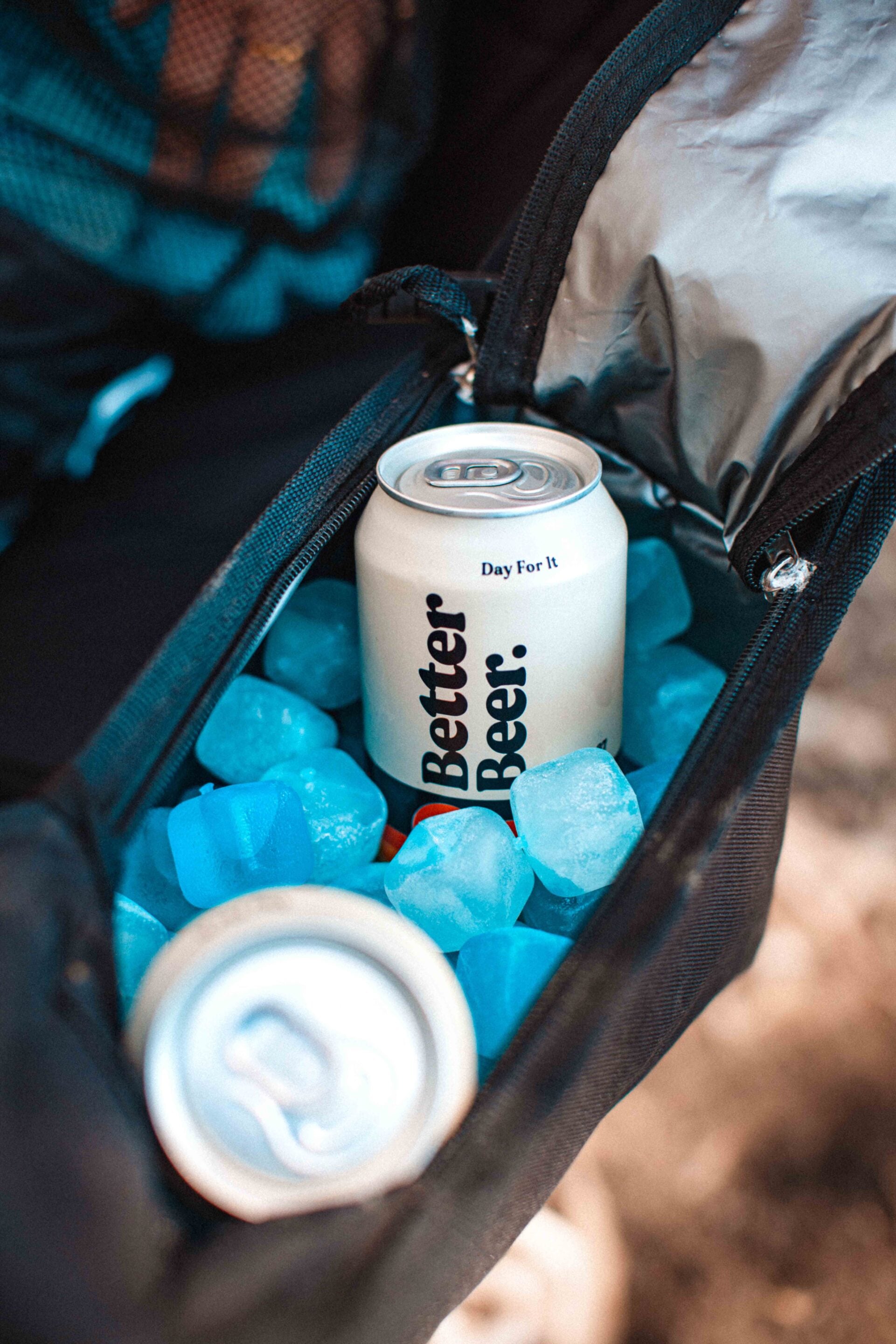
First impressions and build quality
At first glance, reusable plastic ice cubes don’t sound particularly exciting – but opening the box changes that.
The colours are bright and well-finished, the clear cubes look polished and premium, and the multicoloured ones are perfect for camp drinks when someone inevitably asks, “Oi, where’d you get those?”
The cubes are packaged neatly and feel solid in the hand – they don’t have that flimsy novelty vibe that splits open at the first knock. Made from BPA-free, food-safe plastic and filled with purified water, they have no chemical taste or plastic smell and are safe for kids and families. Heat-sealed to survive thousands of refreezes, Ezee Freeze cubes prevent the need for constant ice runs and eliminate messy Eskies.
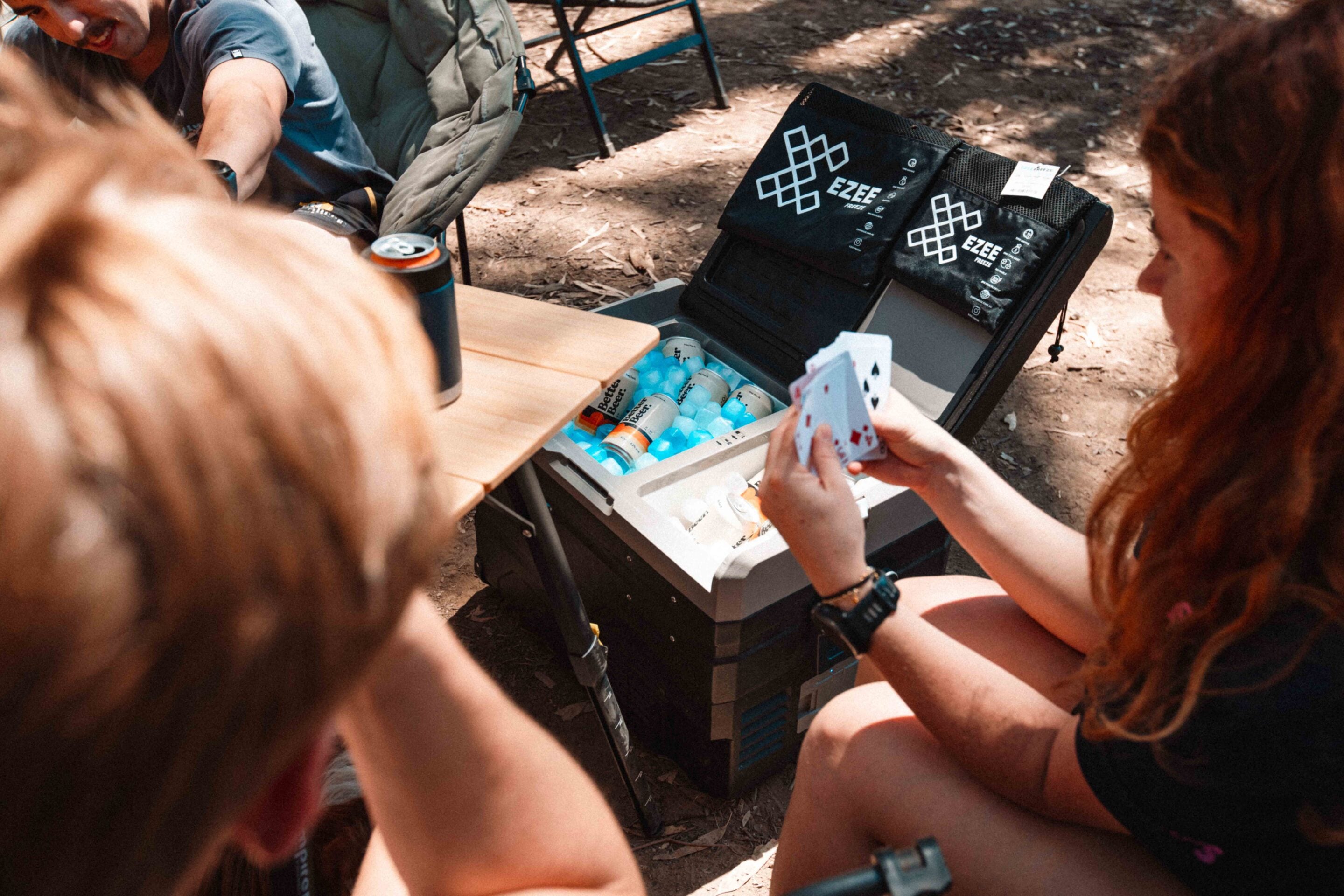
Real-world performance
Ezee Freeze claims the cubes stay frozen for up to 48 hours in an Esky – and in practice, they deliver.
Naturally, constantly opening a cooler in hot conditions will soften them faster, but for standard weekend trips they remain firm and usable for two days. I’ve tested them on long beach runs, fishing sessions, and even hundreds of kilometres bouncing around in the back of a ute.
Not everyone has a high-end 12V setup. For budget builds, weekend warriors, beach rigs, fishing utes, touring wagons and swag setups, Eskies are still king – but melted ice brings its own problems. Ezee Freeze keeps drinks cold, food dry, and the Esky clean. No puddles, no floating meat, no sweaty cheese and no constant draining.
These cubes aren’t just for 4WD trips – they’ve also become useful for lunchboxes, beach days, boat trips, picnics, barbecue prep, and entertaining at home. Mesh storage bags make rinsing and storing easy. Freeze, use, refreeze, repeat – less plastic waste, less water wasted and no mess, all without feeling forced or overcomplicated.
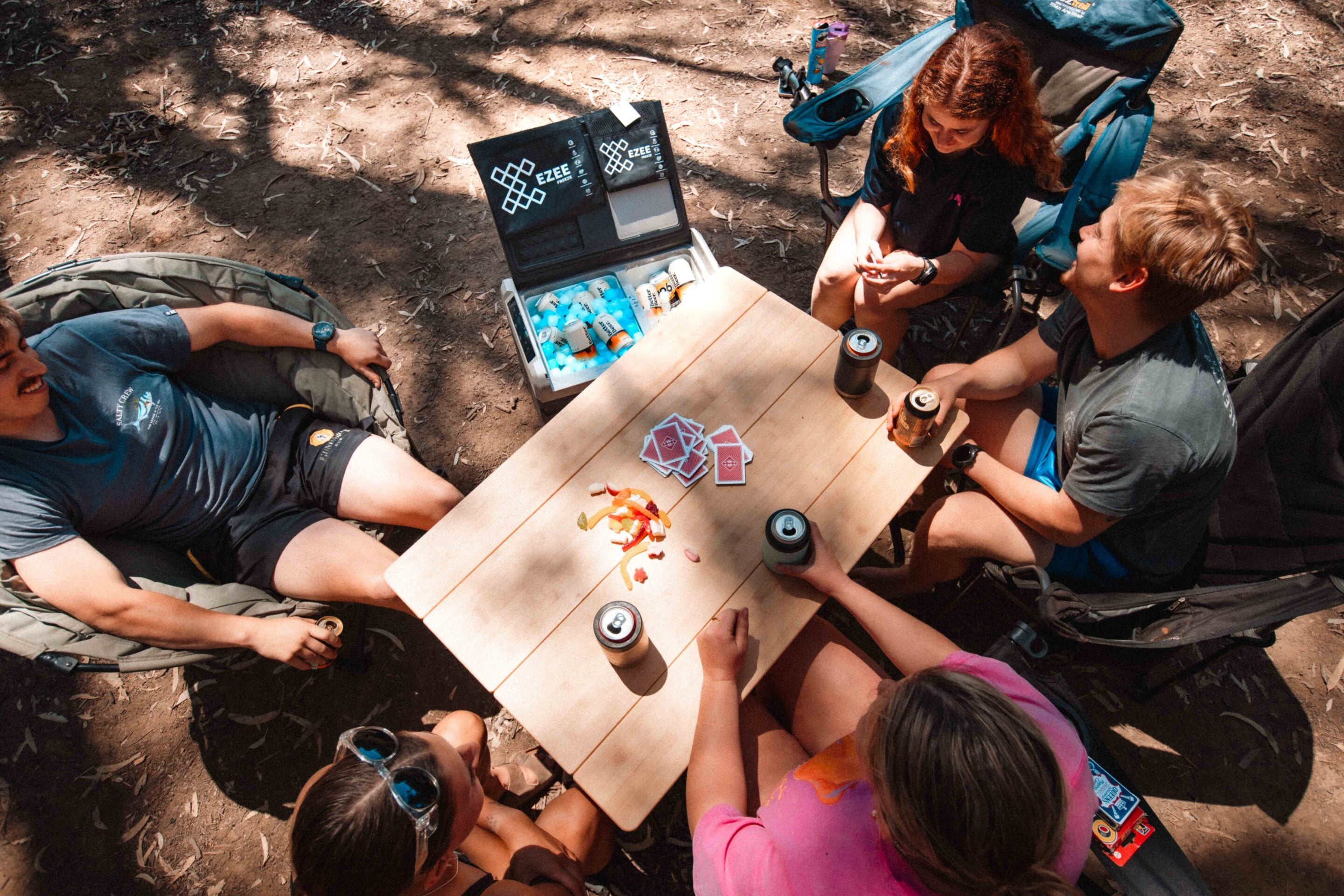
Durability, support, and who it’s for
There are plenty of cheaper knock-offs on the market, but Ezee Freeze stands apart.
BPA-free plastics, purified water, proven 48-hour cooling, consistent quality, Aussie support, and local shipping make a difference. I’ve thrown these cubes in and out of Eskies, left them in the sun, packed them under food, rattled them on corrugations, and even dropped them on concrete – no cracks, no leaks and no failures.
Ezee Freeze isn’t a fridge replacement. For long-term touring, full-time camping or controlled-temperature storage, a 12V fridge is still the way to go. But for weekend trips, beach days, and Esky-based setups, these cubes improve the experience, reduce mess and waste, and save money and time.
Final verdict
The best gear isn’t always the most expensive or flashy – sometimes it’s the items that quietly make life easier.
Ezee Freeze reusable ice cubes work as advertised; stay frozen for up to 48 hours; are reusable, economical, eco-friendly and built for real outdoor use; and they’re backed by reliable Aussie support. If you run an Esky, this is a product you’ll genuinely appreciate.
Pros
- Stays frozen up to 48 hours in real-world use
- Reusable and built to survive thousands of refreezes
- Keeps Eskies clean and dry – no puddles or soggy food
- BPA-free, food-safe, and family-friendly
- Compact, colourful, and durable for real outdoor use
- Eco-friendly and reduces single-use ice waste
- Aussie support and reliable shipping
Cons
- Not a replacement for a 12V fridge on long tours
- Performance can drop if constantly opening the esky in extreme heat
Bri Voto bought her 2006 Nissan GU Patrol in 2018 when she was just 19 years old. At the time, she had almost no 4WD experience – she couldn’t even identify a diff. What drove her was a passion for camping and off-road adventure.
The Patrol quickly became both a challenge and a teacher. Technical tracks, broken diffs, twisted axles and failed tail shafts forced Bri to learn repairs herself, with support from the 4WD community. Over time, she developed the skills to maintain, repair and eventually customise her own vehicle.

Experimenting with set-ups: Wheeling vs Touring
Over the years, Bri experimented with multiple setups: Different tyre sizes, Superior Engineering kits, twin-locked diffs, reduction gears, and balancing off-road toughness with touring practicality.
At first, the goal was to make the Patrol capable of both serious wheeling and long-distance trips. The camping setup included a custom tray and canopy, rooftop tent (RTT), awning and 12V system. The off-road setup included big tyres, reduction gears, twin locks, and bar work. In practice, the two priorities clashed – the canopy had to be removed for heavy wheeling, creating inconvenience and safety concerns.
This experience taught Bri a key lesson: What looks good on paper doesn’t always work in the bush. She refocused her build into a practical, purpose-driven setup, which she describes as a “Temu version of a trophy truck” – tough, capable and functional.
Practical custom build: Weekend Trophy Truck
After more than seven years of tinkering and testing, Bri’s GU Patrol has become a weekend wheeler that balances off-road performance with touring convenience. The build focuses on functionality, road legality and durability, while still looking distinctive.
Rear tub and camping setup
- Custom rear tub by Radius Fabrications with full chromoly tube frame
- Extra-large sliding trundle for spare parts and camping gear
- Unique rear tyre holder on heavy-duty gas struts
- Fibreglass tub sides by Customer Fibre Parts (flipped Series 4 GU front guards and flares, bolt-on/off)
- 60L water tank integrated under the trundle
- Twin ARB air compressors
- Built around the Outback Tourer 1.2 roof-top tent (50kg)
Protection, styling and lighting
- Custom sliders and brush bars integrated into OG Muzzbar bullbar by Radius Fabrications
- Full KC HiLiTES lighting setup
- Wrapped by Square Bespoke in metallic canyon copper gold hexes vinyl with PPF protection
Interior comfort and electronics
- Heated Scheelman seats
- Polaris GPS Maxx head unit, HUD, dashcam, and reverse camera
Driveline, suspension and off-road gear
- 63% reduction gears
- Twin-locked with Harrop
- Superior Engineering 3″ Offroad Pro Kit: long arms, Hyperflex arms, braided brake lines, Bendix brake upgrade
- Nitto Ridge Grapplers
Engine and performance
- P4x4 18g turbo
- P4x4 12mm fuel pump
- P4x4 injectors
- Tune Works custom tune (recently detuned from 250 hp to 200+ hp for reliability)
- Radius Fabrications airbox and snorkel
- UFI upgraded fan
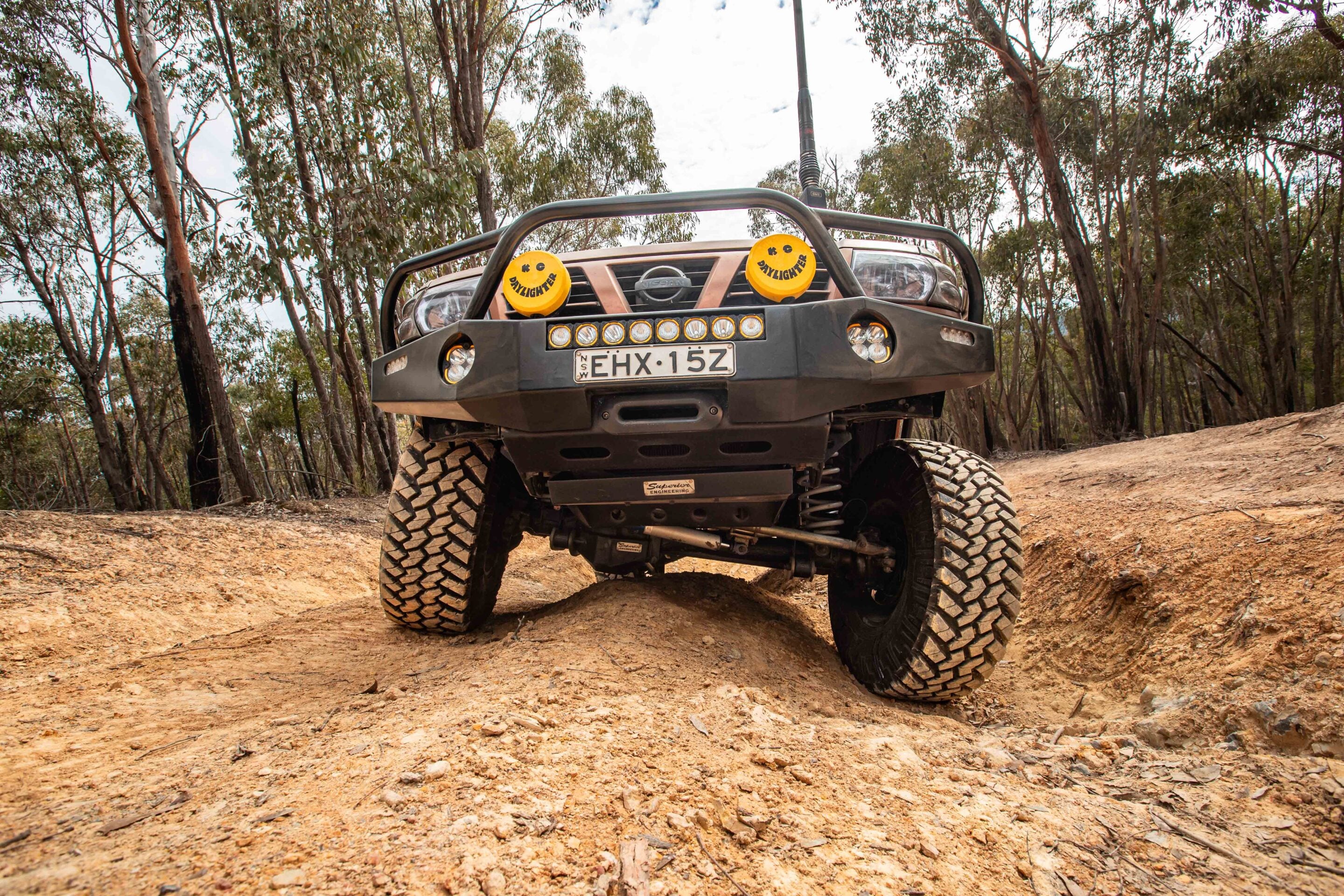
Lessons learned from the GU Patrol
Bri Voto’s GU Patrol is more than a vehicle – it’s a record of hands-on learning and real-world experience. Every diff repair, axle swap, and modification came from testing in the bush.
Today, it’s a capable, practical, and visually distinctive weekend trophy truck, built for those who actually use their 4WD off the beaten track. It proves that with patience, knowledge and trial-and-error, a 4WD can handle serious adventure and everyday touring with equal ease.
When it comes to tyres, every four-wheel driver knows they can make or break a trip. You can spend thousands on suspension, accessories and recovery gear, but if your tyres aren’t up to the job, you’ll come unstuck fast.
For the past 25,000km I’ve been running Kumho Road Venture MT51 (265/60R18) mud-terrain tyres on my Isuzu D-MAX, and they’ve seen just about everything Australia can throw at them. From the rocky climbs of the Victorian High Country to the endless sand of the Canning Stock Route, they’ve performed faultlessly – and, more importantly, they’ve given me the confidence to keep pushing further.
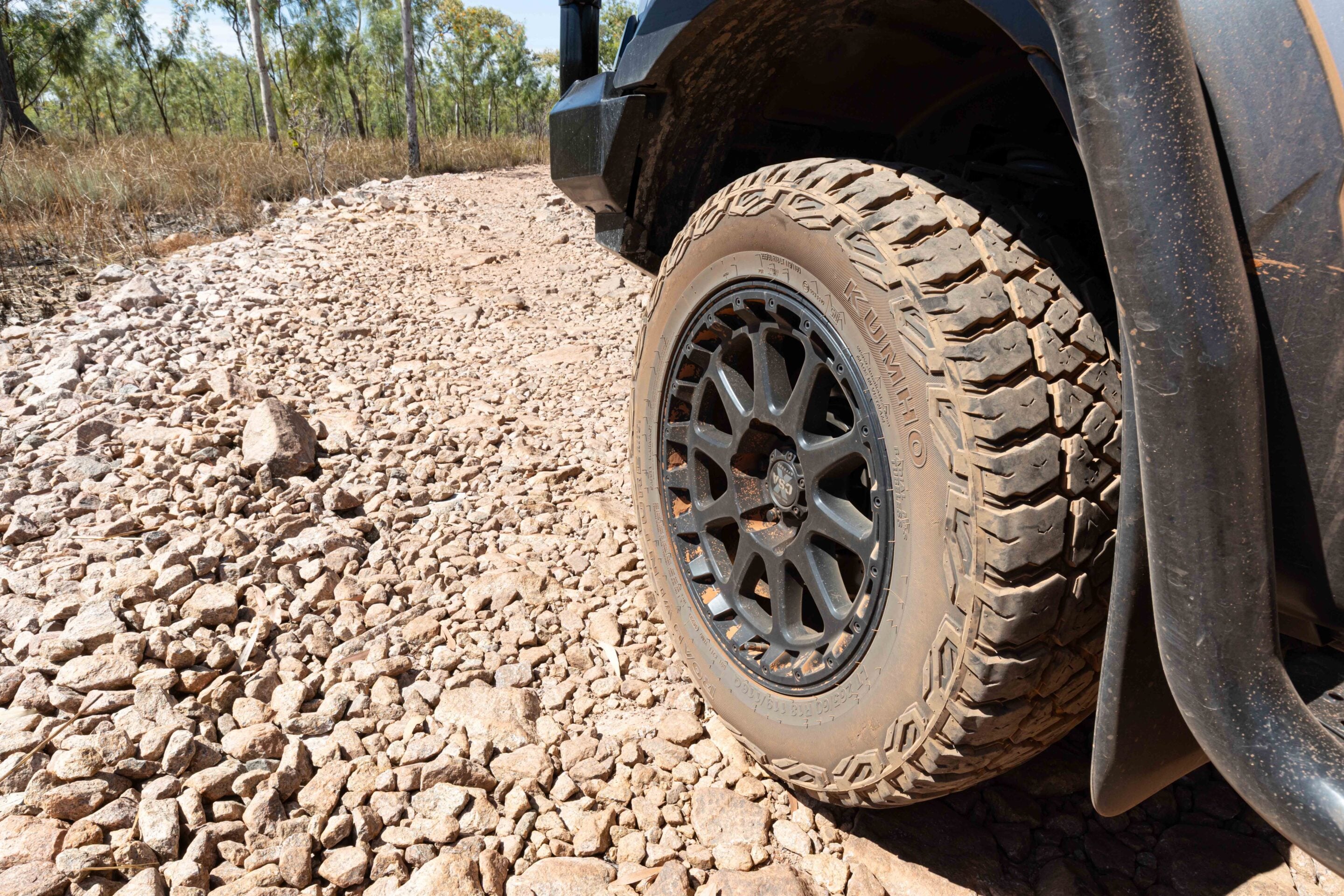
Where they’ve been put to the test
I don’t baby my tyres, but I do respect them. Over the past 25,000km, the Kumho MT51s have seen:
- Victorian High Country: steep, rocky tracks, sharp shale and wet clay descents.
- Canning Stock Route: 1800km of remote desert tracks, corrugations, dunes and soft sand.
- Mary River National Park (NT): bulldust, deep sand, muddy sections and loose soils.
- Litchfield National Park (NT): red dirt, rocky tracks and tropical humidity.
- Outback dirt roads and long stretches of bitumen: from highway hauls to remote station tracks.
- NT beaches: soft sand that will bog you instantly if you don’t set your pressures right.
- Tracks like the Telfer Road (WA): tyre-eating stones used to cap the roads.
In every one of these environments, the MT51s have handled themselves perfectly. Robustness, grip, stability and wear have all been impressive – and considering the mix of terrain, that’s no small achievement.
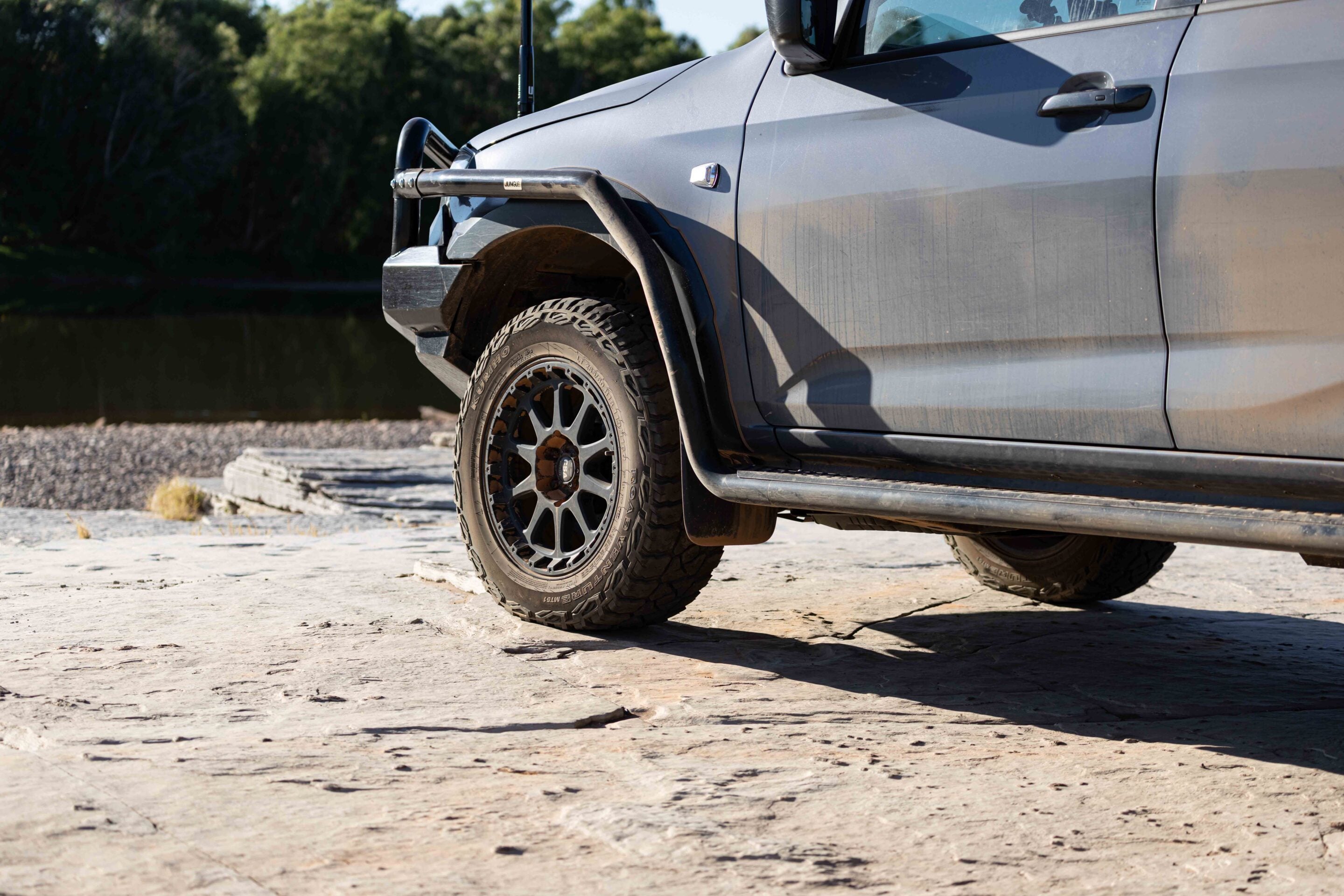
Tread pattern explained
These are proper mud-terrain tyres. The MT51s are built for mud, rocks, loose soil and extreme off-road conditions. The tread pattern is aggressive, with deep, blocky lugs, and the sidewalls are reinforced to resist cuts and damage. If you plan to spend time in dense mud, clay or steep, rocky terrain, these are the tyres you want.
Selecting the correct tyre pressure
One of the biggest lessons I’ve learned over years of touring is that tyre performance isn’t just about tread pattern – it’s about pressure management. The MT51s are excellent, but only when set up correctly for the terrain.
On the Canning Stock Route, I ran them at 20psi through the soft desert sands and dunes. The tyres floated beautifully over the surface, giving me the grip I needed without digging in. In the Victorian High Country, lower pressures were supported by the side biters and three-ply sidewalls, adding strength and stability on rocky climbs. On NT beaches, dropping them down gave me confidence to cruise the soft sand without getting bogged. In the Mary River region, I adjusted pressures depending on whether I was battling bulldust, mud or sandy tracks.
The D-MAX’s built-in tyre pressure monitoring system has been invaluable, providing constant pressure readings and temperature feedback. If a tyre starts heating up too much, I know it’s working harder than it should – a clear sign to add more air. On long corrugated roads, that feedback can be the difference between a trouble-free run and shredded rubber.
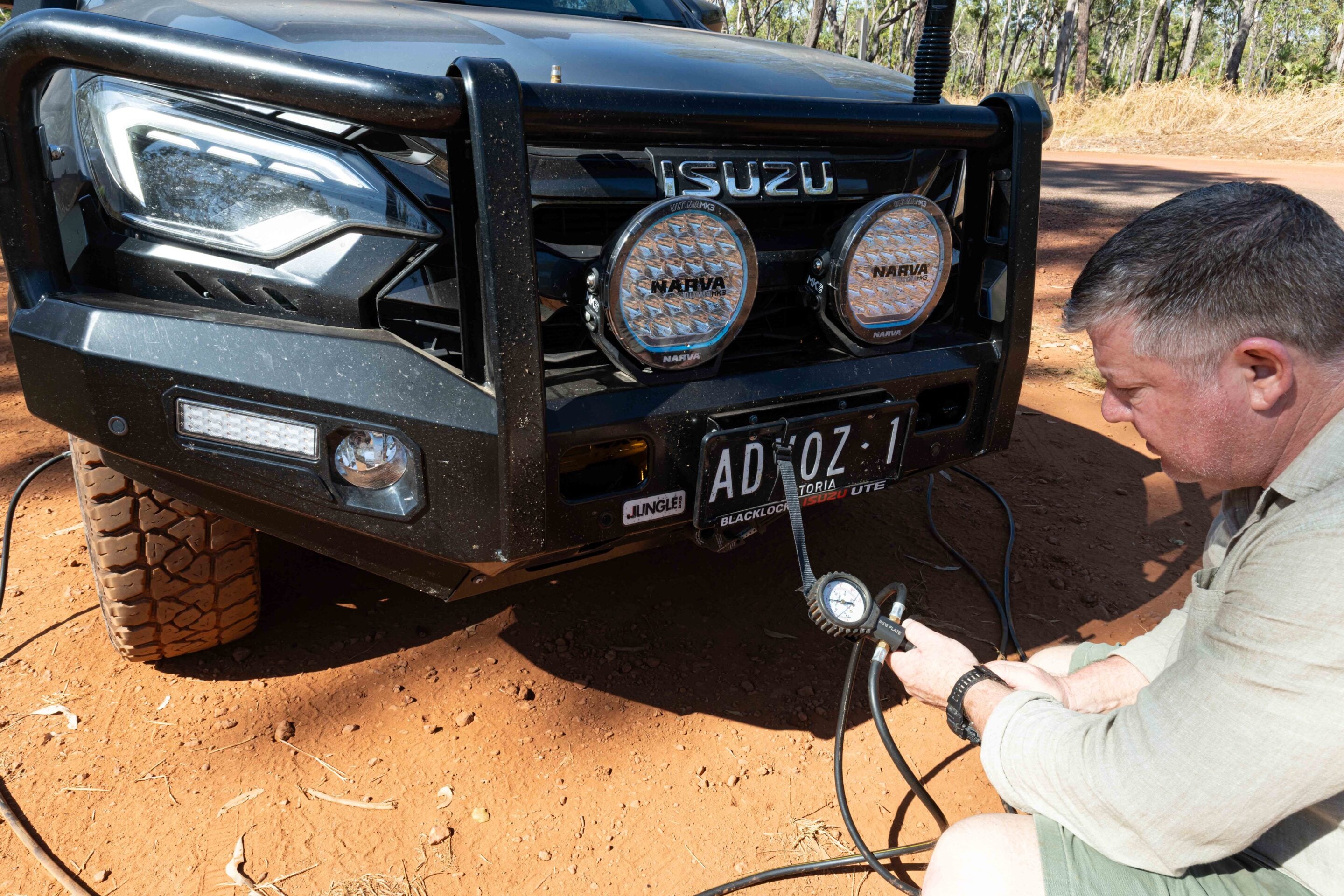
Rotation, checks and maintenance
The MT51s have now clocked 25,000km, and wear has been extremely even. I put this down to a strict but simple routine:
- Rotation every 10,000km, as recommended by Tyrepower, who look after my wheels – including the two spares.
- Visual inspection whenever I stop, checking for cuts, chips, bulges or embedded stones.
- Constant pressure and temperature monitoring via the Isuzu system.
These habits ensure the tyres are always in peak condition, which is probably why they remain in such excellent shape after traversing varied terrain. The sidewalls still look solid, the tread blocks are holding their edges, and there’s plenty of depth left.
On-road performance
Most of us still spend a fair chunk of time on the bitumen. A tyre can be brilliant off-road, but if it drones like a jet engine or feels vague on the highway, it’s a deal-breaker.
On road, the Kumho MT51s are rougher than a standard all-terrain, but surprisingly tolerable for what they’re designed for. Road noise is more noticeable due to the deep lugs, but it’s manageable unless you’re actively listening for it. Handling is predictably firm – especially through corners – and wet grip is noticeably better than many other mud-terrains I’ve used. I’ve covered thousands of highway kilometres between trips, and they haven’t given me a single moment’s doubt about control or safety.
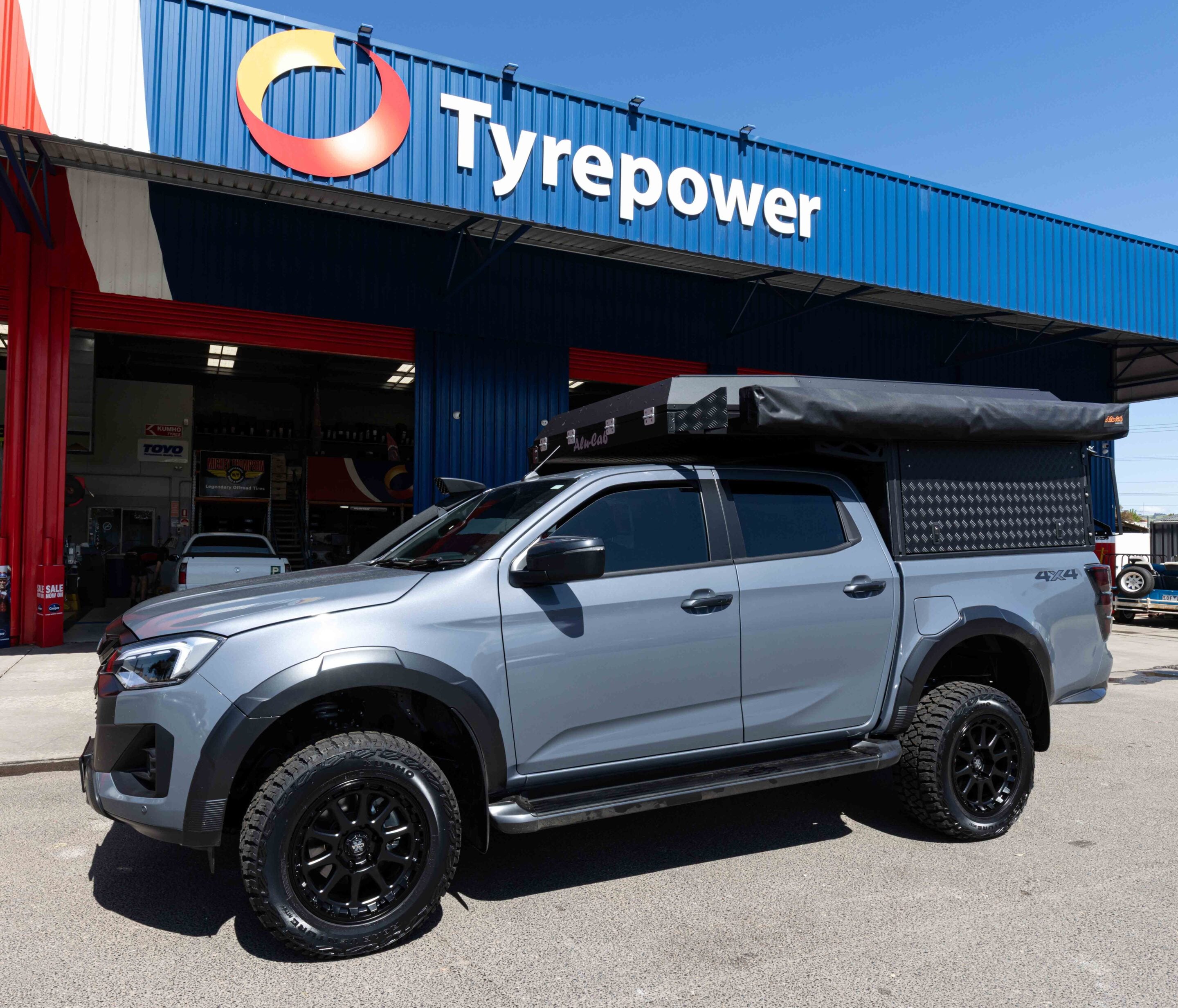
Off-road performance
Where the MT51s really shine is once you leave the blacktop. In the Victorian High Country, I tackled sharp, rocky climbs and loose shale without issue. The tyres gripped consistently, and the tread blocks and side biters took a pounding but came through intact.
On the Canning Stock Route, the combination of sand, corrugations and sheer remoteness is the ultimate tyre test. Running them at 20psi, they floated across the dunes and stayed composed over the corrugations. Despite two weeks of constant punishment, I didn’t suffer a single puncture or sidewall issue – and that reliability alone is worth its weight in gold when you’re hundreds of kilometres from help.
In the Mary River National Park, the mix of bulldust, soft sand and muddy sections gave the MT51s a proper workout. They dug through deep mud, held traction in slippery clay and handled soft sand with ease – provided pressures were right. And in Litchfield National Park, the tyres managed red dirt, river crossings and rocky trails without complaint. Even on NT beaches, where soft sand can swallow vehicles whole, the MT51s performed beautifully.
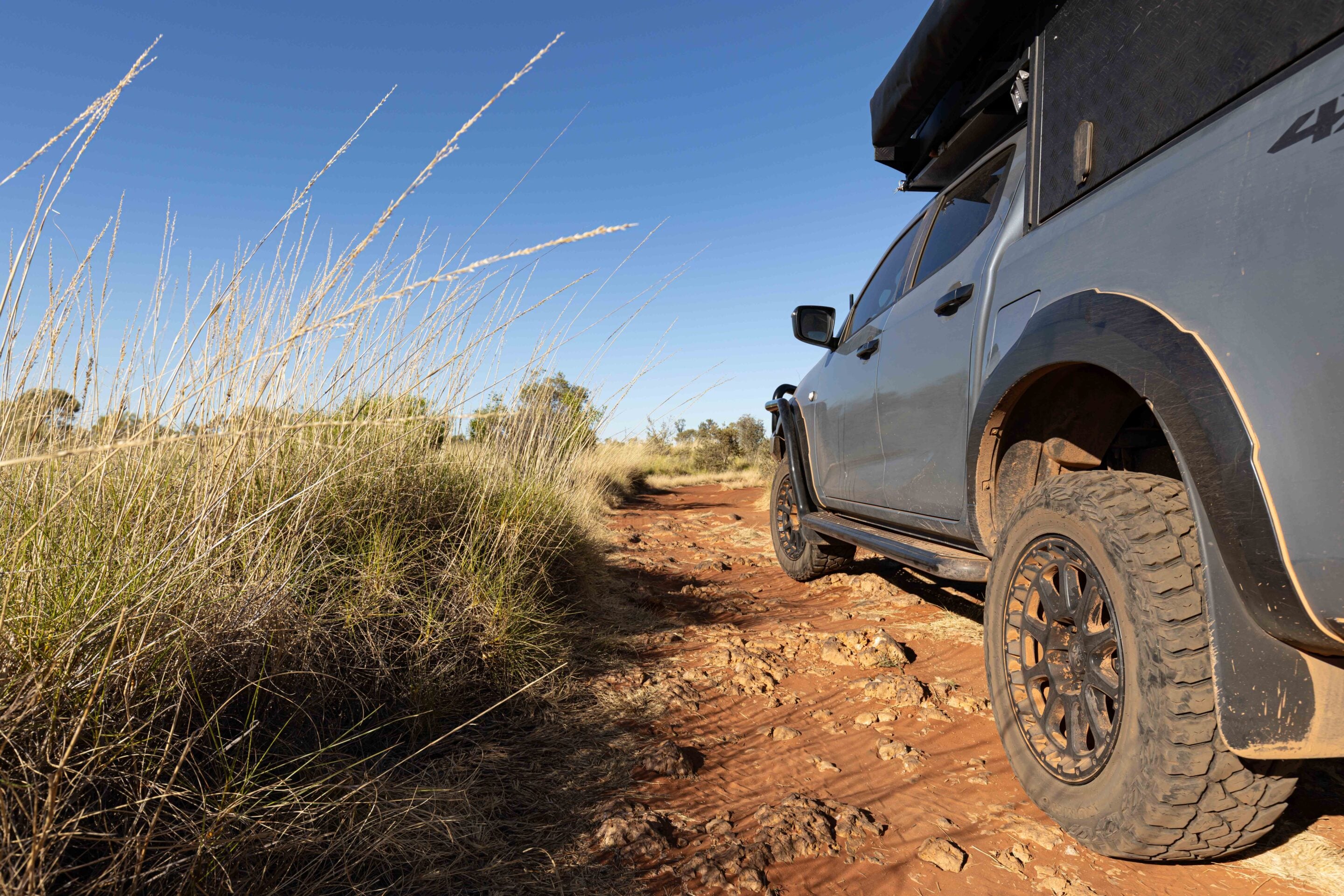
Tyre life and value
With more than 25,000km under them, I’m impressed at how well they’ve held up.
Even with constant rotation and careful pressure management, tyres that see this variety of terrain often start looking rough around the edges. The MT51s still look solid and have plenty of tread left, giving me confidence they’ll easily push past 50,000km – depending on how harshly you treat them.
Considering the MT51’s price point compared to premium mud-terrains, they represent excellent value. You’re getting a serious off-road tyre that can handle desert, rock, sand, clay and highway without paying extra just for a brand name.
Verdict
For me, tyres are all about confidence. When I’m tackling the Canning Stock Route solo or dropping into a steep High Country track, I need to know my tyres will hold up. After 25,000km across some of Australia’s harshest and most varied conditions, the Kumho MT51s have more than earned my trust.
The MT51s have proven robust and exceptionally durable. The strength of their carcass construction is evident in the twin steel belts, polyester casing, jointless nylon cap ply and three-ply sidewalls. The tread compound offers strong cut and chip resistance, and the blocks have held their shape remarkably well.
They are noisier on the highway than all-terrains, but that’s expected. Off-road, they’ve been sure-footed in mud, strong in sand when aired down, grippy on rock and resilient over corrugations. With sensible pressure management, regular rotations and a watchful eye on condition, they’ve delivered everything I could ask for in a mud-terrain touring tyre.
For anyone chasing a reliable, great-value mud-terrain that won’t let you down when the going gets tough, I can confidently recommend the Kumho MT51. They prove you don’t need to spend top dollar to achieve top performance.
- RRP: From $270 each (varies by retailer)
The Cloncurry region in the heart of Queensland’s outback has always fascinated me, though I’ve never really stopped to dig deep.
Explorer Robert O’Hara Burke and his ill-fated expedition passed through here back in 1861 on their race to the Gulf of Carpentaria. They crossed the Selwyn Ranges at the height of summer – a great relief for Burke, whose camels were bleeding and exhausted from the rough terrain – but soon faced wet-season rains and monsoonal heat. He named the Cloncurry River after a good friend in Ireland, and it was after following the Cloncurry into the Flinders River that the party made its furthest northern camp, number 119.

Why Cloncurry deserves more than a drive-through
Today it’s a rich mining town sitting in the shadow of Mount Isa, 120km away – with just as much to see and do, but without the crowds.
The first port of call in Cloncurry for any visitor should be the Unearthed Visitor Information Centre on the eastern side of town. Set on several acres, there’s plenty to see and do, with old mining gear, restored buildings and a fascinating museum inside the main centre.
The old police station on site was originally located miles away at Oona Siding. Built in the early 1900s, it was later pulled down and moved to the small township of Dobbyn, near the Mary Kathleen mine site. It received a full refurb when it was relocated to its current position and is now filled with memorabilia from that era.

Chinaman Dam, lookouts and local mining history
No visit to Cloncurry is complete without a trip to Chinaman Dam for a picnic, a spot of fishing, or – if you’ve brought a boat – a chance to explore the dam itself.
A good viewing point to take in the town, surrounding country and mine sites is the Chinaman Creek lookout and water tower. It’s a great vantage point offering 360-degree views and some fascinating local history panels. In 1867, Ernest Henry explored the area in search of grazing land but, to his surprise, discovered large deposits of copper.
Today, the Great Australian Mine named in his honour still produces high-grade ore. Cloncurry was also the site of a major air force base during the Second World War and is famously where the Royal Flying Doctor Service was founded in 1928. John Flynn chose Cloncurry for its central location near mining camps and pastoral stations – back in the early 1900s, it boasted the largest cattle-selling yards in north-west Australia.

Mary Kathleen, Corella Dam and the Ballara Mining Trail
Most people who travel the road between Cloncurry and Mount Isa to the west know about Mary Kathleen – the now-closed mining town that was literally auctioned off after the nearby uranium mine fulfilled its quotas, never to reopen again.
Midway between the two towns, it sits in the stunning Selwyn Ranges, where Clem Walton and his mate Norm McConachy discovered uranium while prospecting in 1954. Over the years, a town was established to cater for families and workers, but when all contracts were filled by 1982, the town was dismantled and sold off. Rehabilitation works began soon after at significant cost – and the project even won an environmental award for its success.
Today, it’s a free camp where you can literally park on the old house slabs and set up for a week to explore the area, or drive out to the old mine pit, which has since filled with water. The deep blue colour of the water comes from the minerals left in the pit, and around its edges tree branches have become coralised due to the water’s properties.
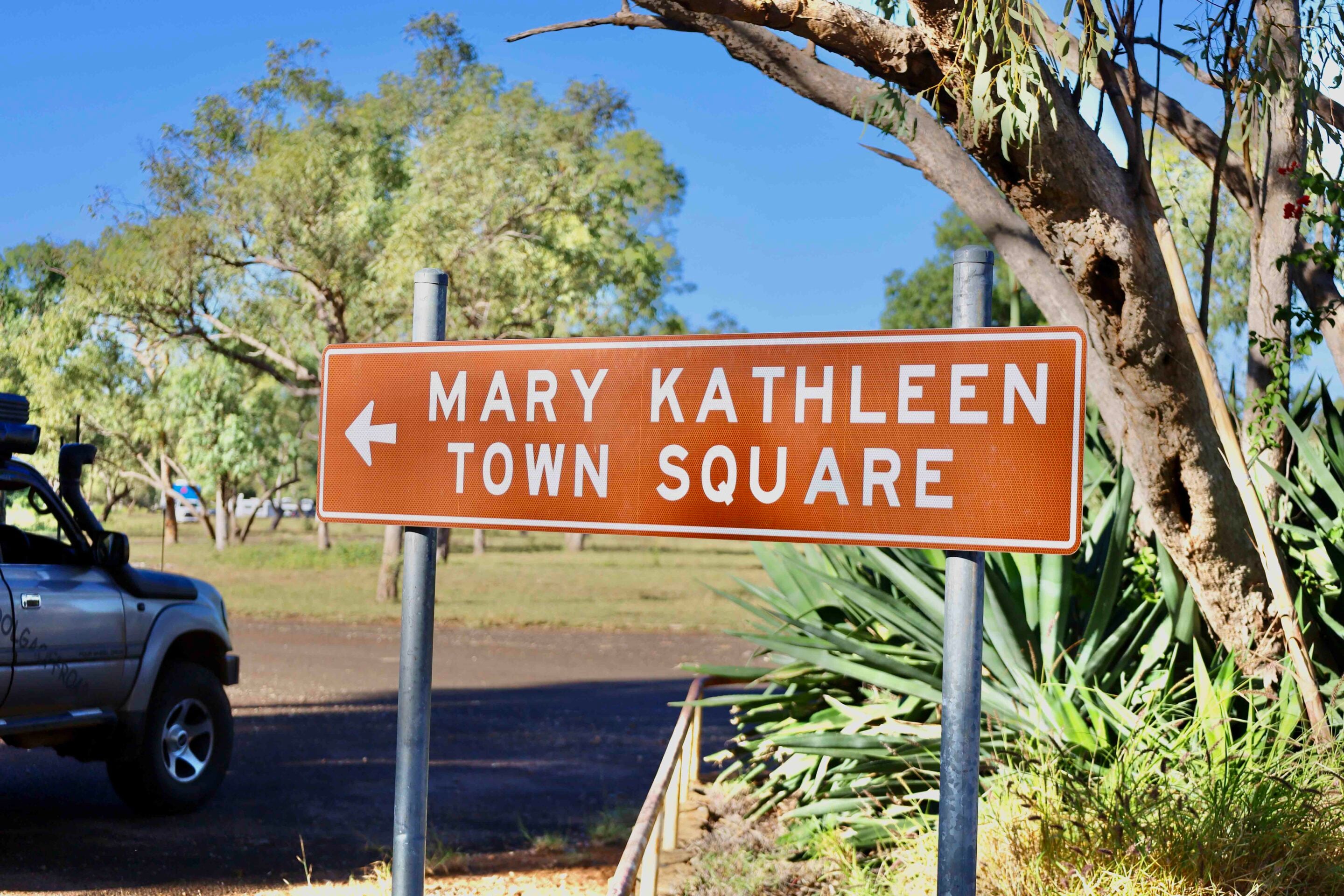
When Mary Kathleen was built, Corella Creek was dammed to create the town’s water supply. South of the site and now known as Corella Dam, it’s another free camping area – popular for its healthy supply of redclaw and freshwater crocs. Southerners often stay for months at a time here, soaking up the serenity and filling their eskies.
Copper was discovered in the Argylla and Selwyn Ranges, and today the Ballara Mining Trail is open to anyone keen to explore the region’s heritage while getting off-road – just up the highway from the Mary Kathleen turn-off. The trail is well signposted, leading to a series of historic sites where you can spend a day exploring old settlements, rail sidings and operational areas. Some of the 4×4 tracks follow the original narrow-gauge rail line to the Wee MacGregor Tunnel and the main mining zone.
Wee MacGregor Tunnel, Hightville and Fountain Springs
The Wee MacGregor tunnel is heritage listed, and it’s pretty cool to walk through – dodging the colony of bats that now calls it home.
At the other end, there’s an amazing view down to the old mine site, where the rail line once twisted its way around the mountain. You can still see the hand-laid rock walls that supported the track along the rocky ridgeline. The track down to the Hightville mine is narrow and steep, suitable only for high-clearance 4x4s due to the severe storm damage that’s regularly caused here in the wet season – but it’s well worth the effort.
It amazes me how they managed to get equipment down to these places back then – today there’d be far too much paperwork. Water was a major issue in this region, according to the history boards along the way. Some years, mining was suspended due to a lack of water, while in others the mines were flooded, creating even more headaches about how to pump it out. In some cases, operations stopped altogether.
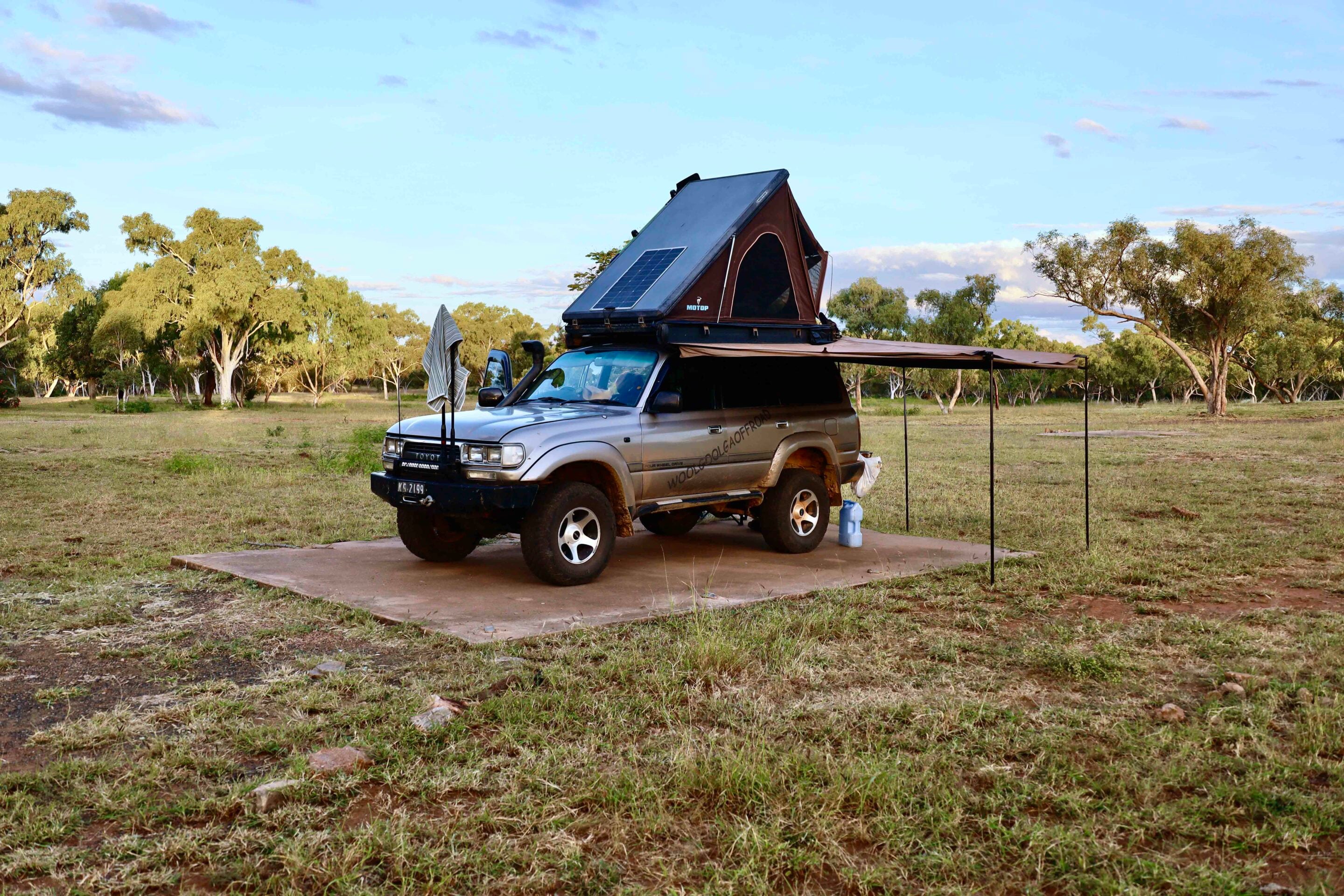
Left of the harsh mining zones in the Selwyn Ranges lies a worthwhile detour to Fountain Springs Waterfall – an oasis that offers sheer relief from the outback heat on any given day. This natural waterhole holds great significance for the local Kalkadoon people, who have lived in the region for millennia.
It served as both a meeting place and a vital water source while they hunted through the surrounding country. And while Cloncurry might seem like just a quick drive-through town, there’s plenty to see and do before heading off in any direction.
Essential travel information
Where and how to get there
Located on the Flinders Highway, Cloncurry sits 785km west of Townsville in the heart of Queensland’s outback. It’s also the gateway to the Gulf of Carpentaria, just 400km to the north, while an hour to the west lies the mega mining city of Mount Isa, where most major industries and services can be found.
What to see and do
The greater Cloncurry region has plenty to see and do. The town itself is steeped in history, and you can easily spend a day relaxing at Chinaman Dam just out of town. Head a little further west to camp at the old Mary Kathleen township or at nearby Corella Dam. You can also tackle the self-drive 4×4 track to the historic Ballara mining site, walk through the old Wee MacGregor Tunnel, or visit the Mary Kathleen mine, which was once a working uranium pit.
Other useful information
Cloncurry has an informative tourist information centre and museum on the eastern side of town, where staff can give you a full rundown on the town’s history. You can also wander through the old buildings on site and explore the various mining relics. For more information, visit www.experiencecloncurry.com.
Exploring Corella Dam, the self-drive Ballara Mining Trail and the Mary Kathleen site is completely free, with all three located roughly midway between Cloncurry and Mount Isa.
When it comes to off-grid touring, nothing provides peace of mind quite like a dependable power setup.
Travelling deep into Australia’s most remote tracks and national parks, I needed solar I could rely on to keep everything running – from the fridge and freezer to my cameras, water system, and even an induction cooker.
That’s why I opted for two 200W Projecta solar panels, mounted permanently on the roof of my Alu-Cab Canopy Camper and wired in parallel. Together, they deliver 400W of solar power, feeding into a 400Ah lithium battery via a Projecta 40A MPPT solar charger. And here’s the kicker – my DC-to-DC charger still isn’t connected, so solar has been the only charging source since I left home. Despite that, these panels have kept me running day in, day out, across some of the most demanding off-grid conditions Australia has to offer.

Setting it up
Mounting the panels was straightforward.
The design of the Projecta units allowed them to sit neatly on the canopy rails without adding unnecessary bulk or creating clearance issues, thanks to the low-profile Razed Products Solar Panel Mounts. They’re robust enough to handle the rough corrugations, bulldust, bush pinstriping and relentless red dirt that come with remote travel.
Wiring them in parallel was a deliberate choice. Some people prefer series for the higher voltage and reduced cable losses, but I wanted redundancy. In a series setup, if one panel is shaded – say by a tree branch or even the way I’ve parked at camp – the whole system suffers. By wiring in parallel, each panel works independently. If one’s compromised, the other still pumps out power. In real-world conditions, that makes a massive difference.
That’s especially true when travelling through varied environments. Out on the Canning Stock Route, shade isn’t much of an issue – it’s wide-open desert with sun blasting down all day. But in places like Mary River National Park or shady campsites in Litchfield, partial shading can cut into your harvest if you’re not careful. Running the panels in parallel has been the right call for me.
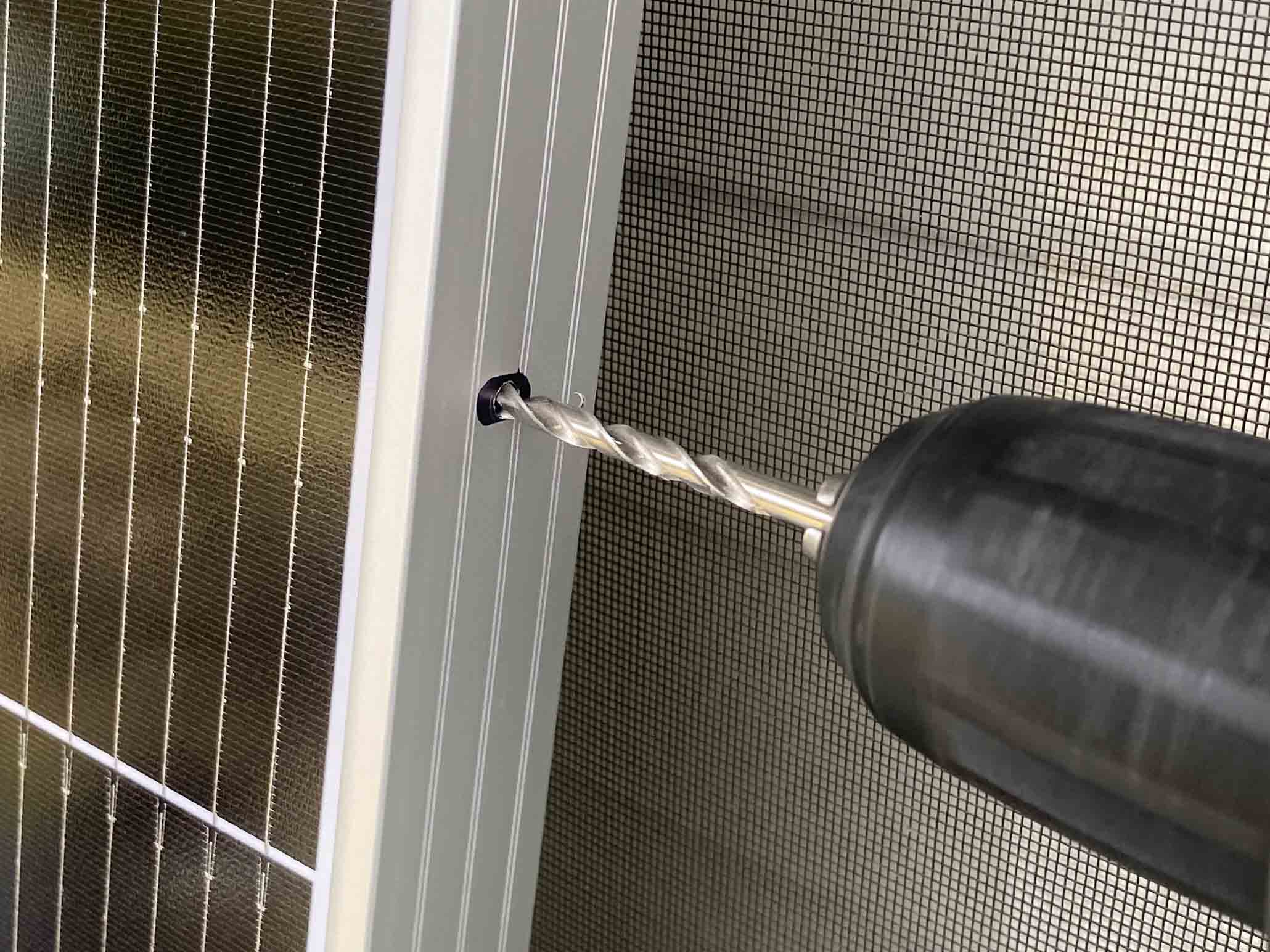
Lithium battery
The Projecta panels are feeding into a 400Ah lithium battery in my canopy.
Lithium has become the go-to choice for serious touring setups thanks to its deep-discharge capability, faster recharge times and lighter weight compared to AGM. But even lithium is useless if it’s not being charged consistently.
That’s where the Projecta panels have impressed me most. I’ve been running solely on solar for weeks, and they’ve kept up with everything I’ve thrown at them – fridge, freezer, water pump, cameras, drone batteries, laptop, phones, lights, even induction cooking. That’s a heavy load, but the battery has taken it all in its stride.
It’s not just about wattage either. Quality panels like these consistently deliver their rated output in good conditions, something cheaper units I’ve tested have failed to do. On a bright day, I can watch the current pour into the battery, and it’s a great feeling knowing I’m harvesting free power while I’m out exploring.

Put to the test
This setup hasn’t been tested in a backyard – it’s been proven across some of the toughest touring environments in Australia.
Canning Stock Route: The ultimate challenge. Weeks off-grid, no services and zero backup if something fails. The Projecta panels didn’t skip a beat. The battery stayed charged every day, even during extended stops. Out here, power isn’t a luxury – it’s survival.
Mary River National Park: A completely different environment – humid, shaded, and full of tree cover. This is where wiring the panels in parallel really paid off. Even with partial shading, I still saw steady input to keep the system happy.
Litchfield National Park: With its mix of waterfalls, shaded camps and variable light, Litchfield is a true test of consistency. The panels handled it with ease.
And here’s the standout: I went 12 straight days relying only on solar to recharge my 400Ah lithium battery – travelling from Katherine in the NT to Marble Bar in WA via the remote Duncan Road and the legendary Canning Stock Route. No DC–DC charger, no alternator input, just pure solar power keeping everything running. That’s a real-world test of endurance, and the Projecta panels passed with flying colours.
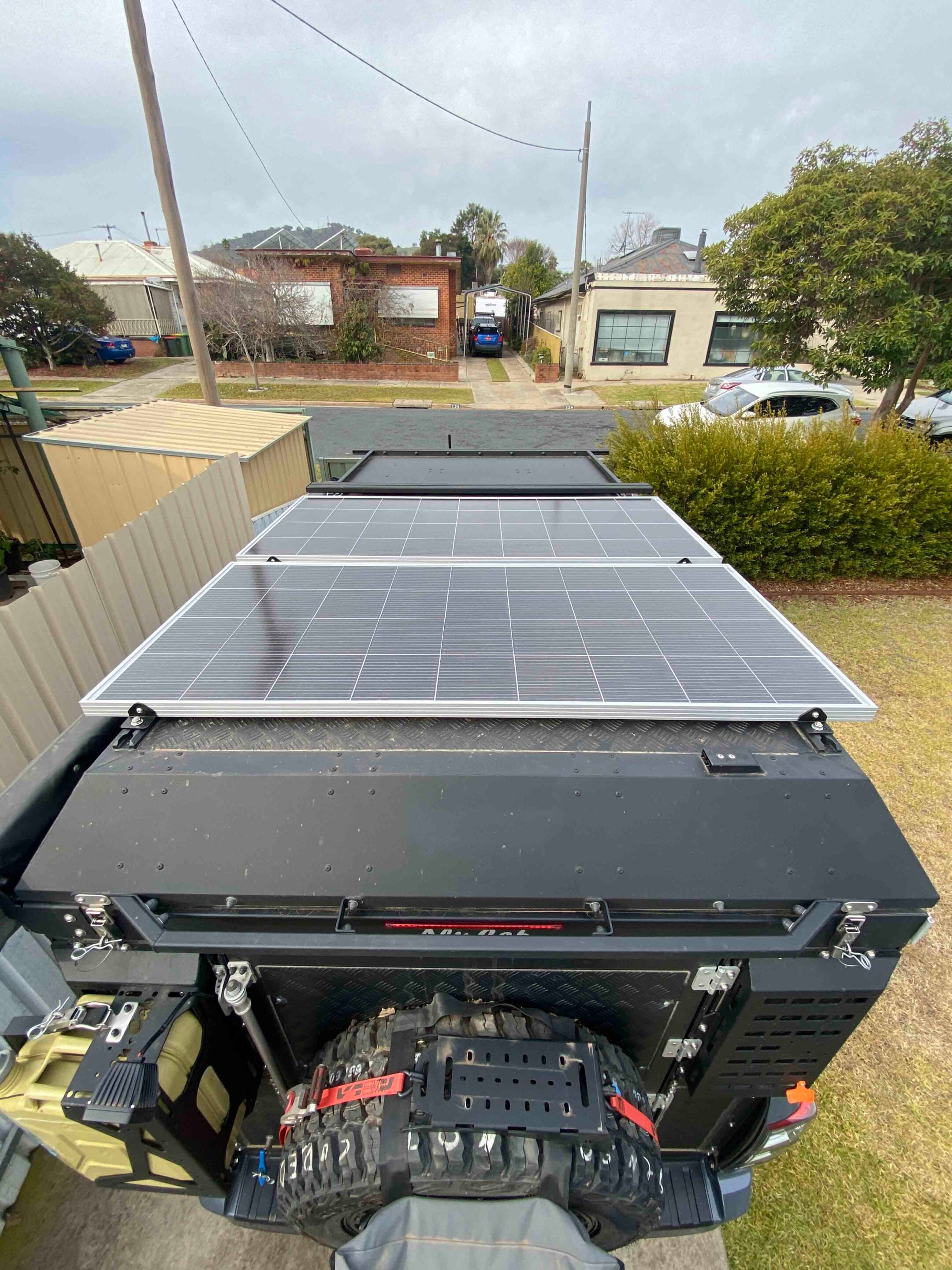
Real-world test
What this setup has delivered, in real-world terms, is freedom. I haven’t had to stress about power once – no need to plug into 240V AC, no reliance on alternator charging.
- Fridge and freezer: Both have run non-stop without missing a beat. Cold food and ice-cold drinks, even in 38°C heat.
- Water system: Always powered, giving me showers, drinking water and washing-up whenever needed.
- Charging gear: Cameras, drones, phones, laptop – all charged, all the time. No rationing power, no hesitation about plugging something in.
- Cooking: The biggest surprise has been being able to run an induction cooker. Normally that’s considered too power-hungry for solar alone, but paired with 400Ah of lithium, the Projecta setup has handled it with ease.
For anyone who’s travelled remotely, you’ll know how much this changes the game. When you can trust your power, you can stay off-grid longer, explore further and travel with absolute confidence.

Key specs
- Type: Monocrystalline fixed panel
- Output: 200W
- Size: 1476mm (L) x 670mm (W) x 35mm (D)
- Frame: Heavy-duty, corrosion-resistant aluminium
- Glass: Toughened, low-iron tempered glass for optimal sunlight capture and long-term durability
- Connectors: Standard MC4 plug-and-play
- Warranty: 1 year (materials and workmanship), 20 years (minimum 80% rated output)
- Best for: Permanent canopy or roof installation on 4x4s, campers, caravans and motorhomes
Verdict
Projecta’s 200W solar panels have proven themselves where it counts. From the harsh desert stretches of the Canning Stock Route to shaded NT campsites, they’ve kept my system running faultlessly.
Managing 12 consecutive days powered only by solar – from Katherine to Marble Bar – is the best proof I could ask for. Wiring them in parallel has paid off big time, delivering consistent charge regardless of shade or cloud. Combined with my 400Ah lithium battery, the setup has turned my canopy into a fully self-sufficient, off-grid powerhouse.
Would I recommend them? Absolutely. If you’re planning extended remote travel and want solar you can rely on – not just for weekends, but for the long haul in the middle of nowhere – these panels are worth every cent. For my touring lifestyle, they’ve been nothing short of outstanding.
- RRP: $450
Pros
- Reliable power output, even in harsh conditions
- Parallel wiring adds redundancy and minimises shading losses
- Built tough for corrugations and rough touring environments
- Plenty of grunt to sustain heavy electrical loads
- Genuine peace of mind when you’re days from the nearest power point
Cons
- Fixed mounting means you can’t move the panels to follow the sun like portable units
- Parallel wiring requires slightly heavier cabling to safely handle the increased current
Rolling down the Stuart Highway after a long day on the road, I was glad to pull into the Adelaide River Inn.
Perched about 112km south of Darwin and 200km north of Katherine, it’s a welcome sight for travellers chasing fuel, food or just a cold beer. The bonus? There’s a caravan park out the back, so you can camp up without leaving the action. That’s exactly what I did – grabbed a site and set about exploring what makes this pub one of the best-known stops in the Top End.
Adelaide River Inn vibes
The place is buzzing. Trucks rumble in, tourists spill out of 4x4s and locals drift across from nearby properties.
The 303 Bar and Bistro sits at the heart of it all – air-conditioned and lined with Territory memorabilia. Out back, the beer garden sprawls with shaded tables, a small kids’ playground and the familiar clack of a pool table. Open daily from 9am to 10pm, it’s the kind of place where you can settle in and feel part of the flow straight away.
Inside the front bar stands the pub’s most famous resident – Charlie the buffalo, immortalised in Crocodile Dundee. He’s still pulling a crowd decades after his big-screen debut.
But Charlie isn’t the only giant here. The Inn is also home to Jock the croc – a five-metre, 720kg saltie who once terrorised boats around Borroloola. He eventually met his match and has since been preserved, taking pride of place as another reminder that in the NT, nature always calls the shots.
By late afternoon, the beer garden fills with chatter as Happy Hour rolls around – schooners $6.50 and house wine $4.50 from 5pm to 6pm (at the time of writing) – with live entertainment keeping the vibe going. A steady crowd gathers for “Jag the Joker”, a daily punt where tickets are $2 each or six for $10. Add in Keno flickering in the background and the atmosphere feels like a mix of pub, carnival and country gathering.
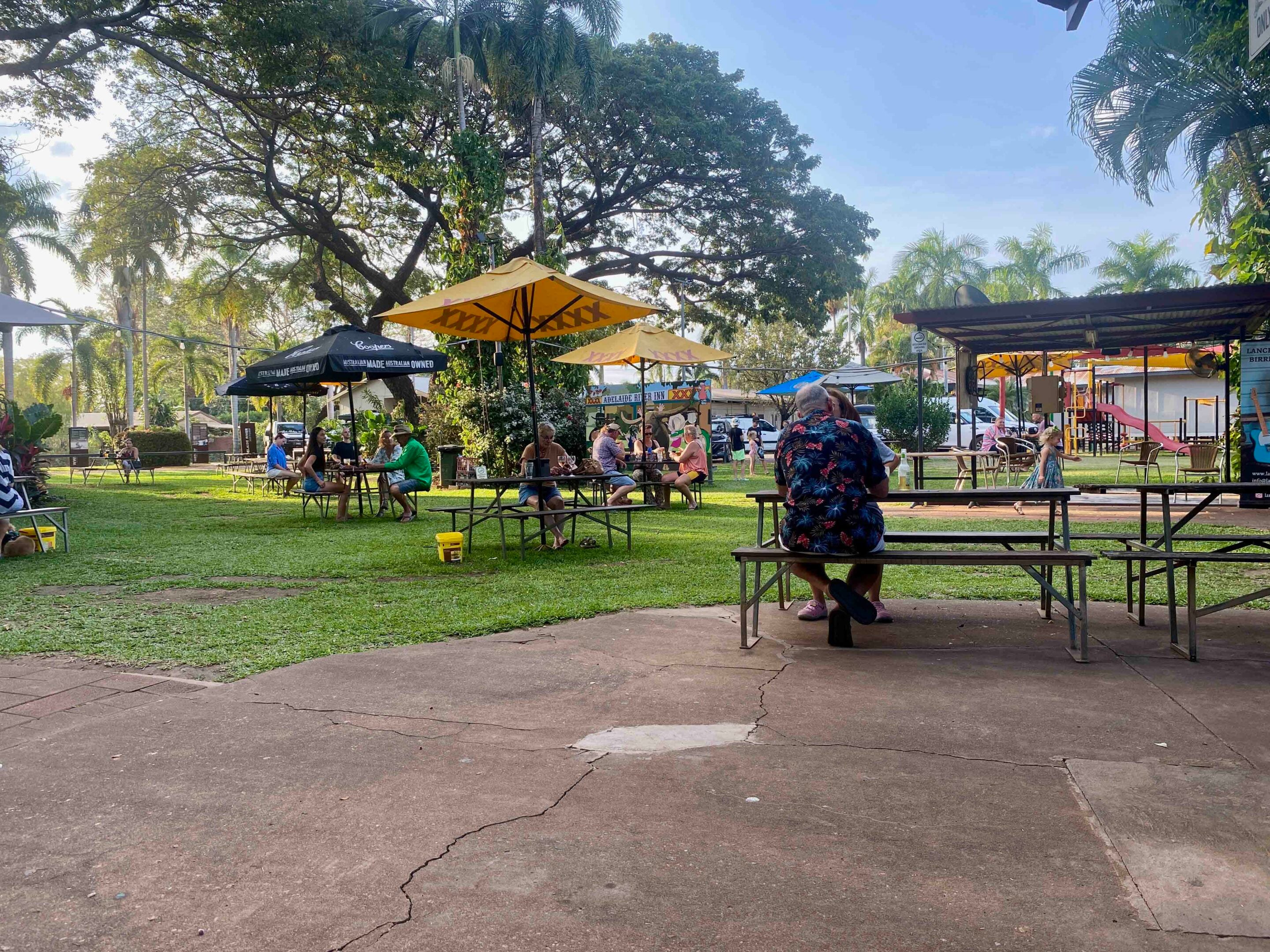
The drinks list is extensive, with a solid range of beers on tap, a decent spread of spirits, and plenty of ready-to-drink cans, stubbies and wines. Nothing fancy – just the kind of selection that ensures no one goes thirsty.
I made the rookie mistake of ordering the Barra Burger for lunch. It sounded promising – a fillet of barramundi with lettuce, tomato, beetroot, onion, cheese and aioli, all stacked in a bun with chunky seasoned chips on the side. Unfortunately, it missed the mark. I’d expected a battered fillet but instead got a grilled one that didn’t hold together. Throw in some odd melted cheese and the whole thing quickly fell apart.
Dinner was a different story. I went back to basics and ordered the Premium Scotch Fillet – about 300g of MSA-grade beef, cooked perfectly medium-rare and served with pepper sauce, salad and chunky chips. It was everything you’d want from a Territory pub feed: big, juicy and satisfying after a long day. Lesson learned – when in doubt, stick with the classics.
If you’re more adventurous, the menu’s got a couple of NT specialties worth a go. The Wild Caught Territory Beef Burger is seasoned with native bush spices, while the Territory Croc Burger serves up a patty of 100 per cent croc meat topped with creamy aioli. When in the Top End, why not lean into the local flavour?
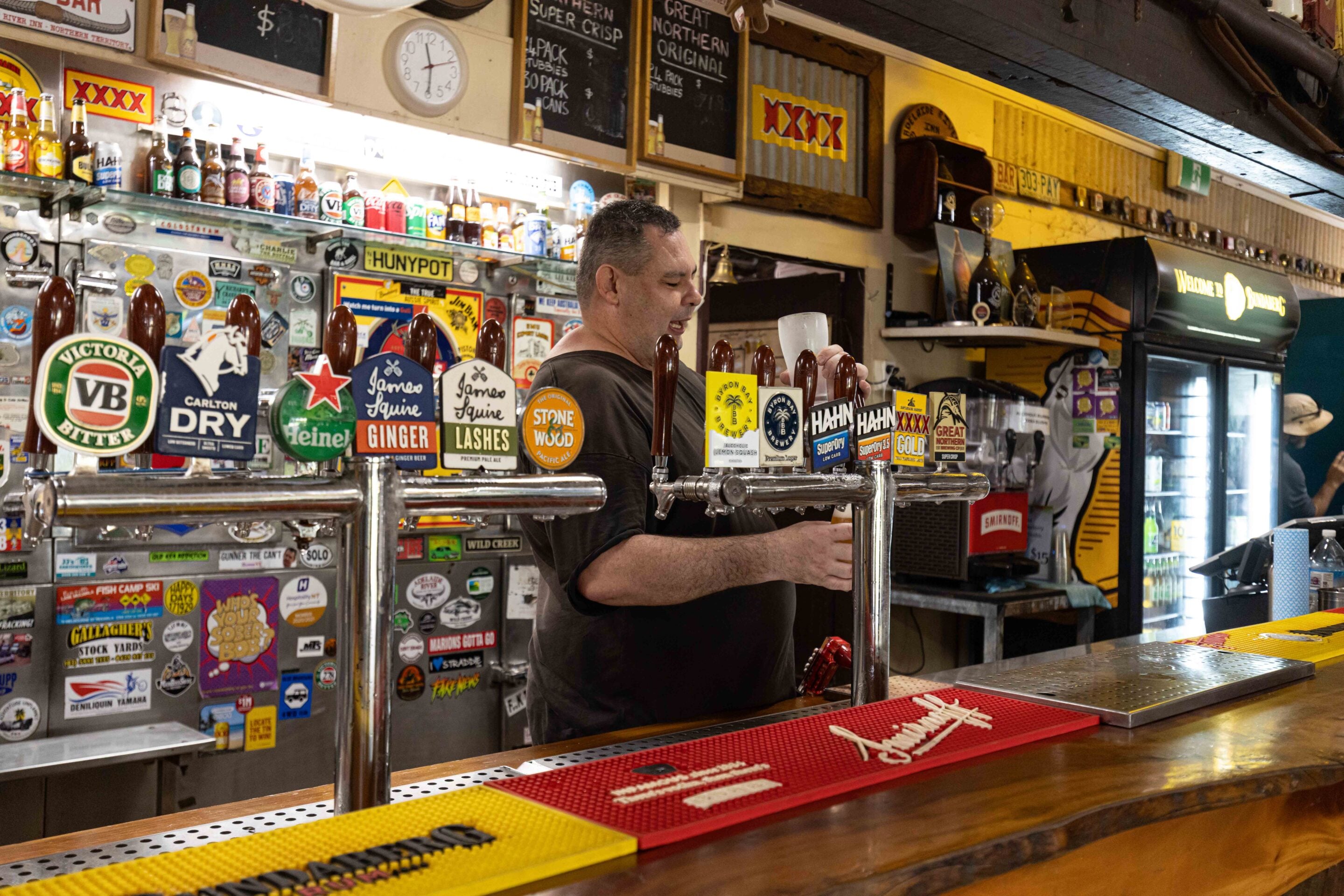
Stay and camp on Stuart Hwy
Camping out the back was simple but spot-on for what I needed.
The caravan park offers a range of accommodation options plus powered and unpowered sites, hot showers, shade and even a pool to wash away the red dust. After a long, hot day on the road, that pool was pure bliss. You can’t book a site here – it’s first come, first served.
The caravan park also features clean amenities and laundry facilities, including coin-operated washing machines and dryers. Two covered camp kitchens with free barbecues are available if you’d rather cook your own than dine at the hotel.
The Adelaide River Inn offers a range of accommodation options to suit different budgets – from fully self-contained ensuite cabins to renovated motel rooms and air-conditioned ensuite budget rooms – all within easy walking distance of the hotel.
My Alu-Cab Canopy Camper made it easy: roll in, fuel up, grab a bite, have a drink and settle in for the night without moving the rig again. By morning, I was recharged and ready to continue north along the Stuart Highway after grabbing a couple of bacon-and-egg toasted sangas from the servo.
Why stop at Adelaide River Inn
The Adelaide River Inn isn’t just a pub – it’s a slice of the Territory; part watering hole, part tourist stop, part history lesson and part local hang-out.
It’s where Charlie the buffalo and Jock the croc remind you that the NT is like nowhere else. It’s where a cold schooner at Happy Hour tastes even better after a long drive. And it’s where travellers like you can camp, eat and have a yarn before heading back out onto the Stuart.
Sure, skip the barra burger – but don’t miss the steak, the beer garden or the buzz of the place. The Adelaide River Inn has well and truly earned its reputation as one of the great Top End pubs.
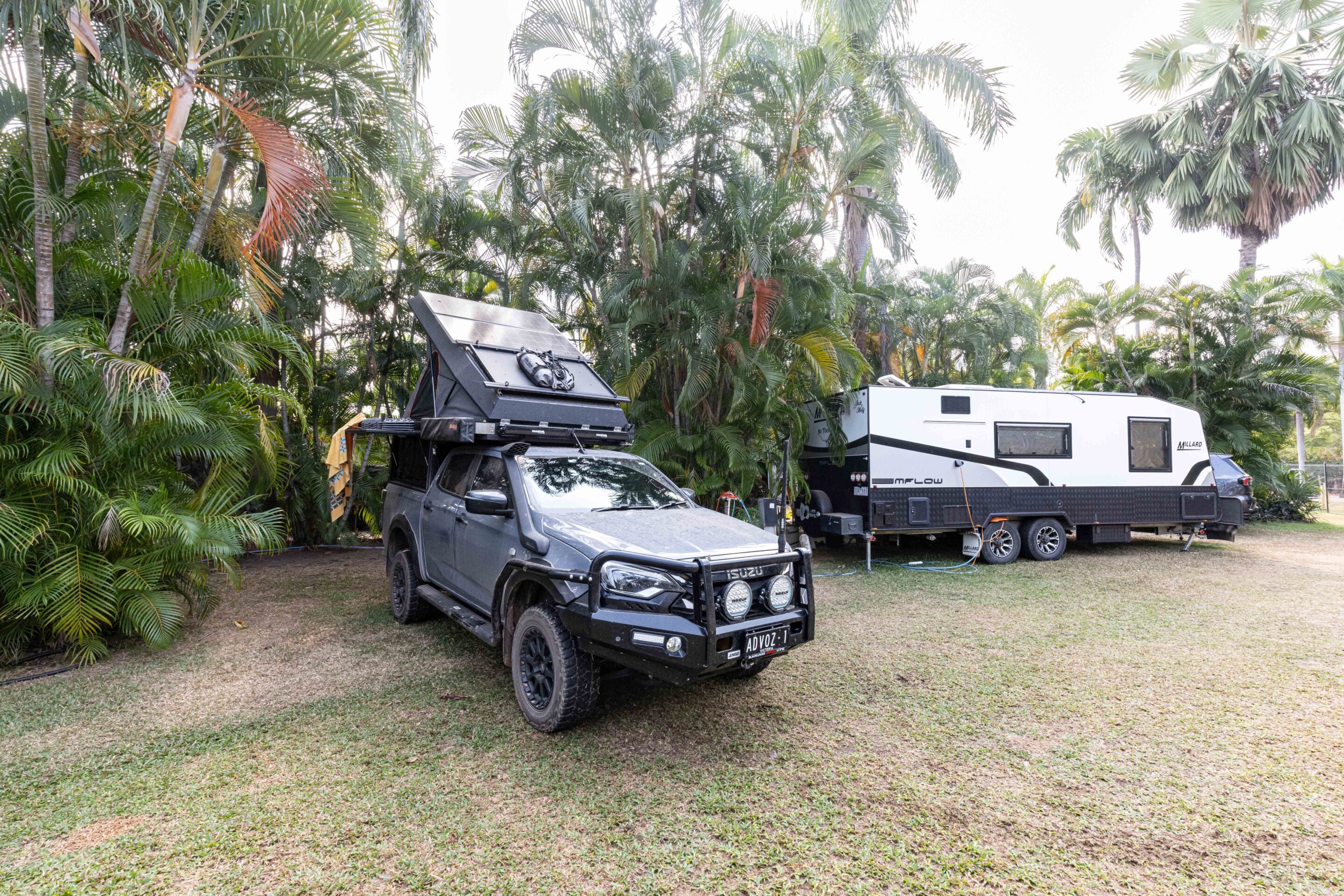
Essential facts
- Location: 106 Stuart Highway, Adelaide River, NT
- Phone: (08) 8976 7047
- Web: www.adelaideriverinntouristpark.com.au
- Beers on tap: XXXX Gold, Carlton Dry, Heineken, James Squire Ginger Beer, James Squire Lashes Pale Ale, Stone & Wood Pacific Ale, Byron Bay Brewery Alcoholic Lemon Squash, Byron Bay Brewery Premium Lager, Hahn Super Dry Low Carb, Hahn Super Dry 3.5, Great Northern Super Crisp and VB.
- Food highlights: Steak Sanga, Chicken Parmy, Wild Caught Territory Barramundi (pan grilled or beer-battered), 303 Bar Beef Burger, Territory Croc Burger, Wild Caught Territory Buffalo Burger, Premium Scotch Fillet, Wagyu Rump, Barbecue Pork Ribs, Boss Drover Bangers & Mash, Fish & Chips, Grilled Calamari, Kids’ Meals, Daily Specials Board.
Long before the INEOS Grenadier touched down in Australia, the team behind Expedition HQ were already deep in the business of building vehicles designed to cross continents, not just sit in carparks.
The roots go back to SLRV Expedition Vehicles, a name well-known to anyone who’s walked a remote outback track and seen one of those big, go-anywhere rigs rolling past – they’re impossible to miss. The business wasn’t born from marketing strategy – it came from a simple, old-fashioned desire to build machinery capable of surviving remote travel.
Heavy-duty 4x4s engineered for corrugations, isolation and long-haul living were its foundation, and that experience in durability and reliability forms the DNA that later became Expedition HQ.
So when the Grenadier arrived in 2023, promising a modern take on a traditional 4WD formula, the SLRV team saw a familiar brief – a tool built around utility, mechanical simplicity and long-range capability. And that’s where Expedition HQ starts.
From Expedition vehicles to expedition builds
Expedition HQ emerged from a practical need. The Grenadier offered a platform with genuine potential, but the Australian aftermarket wasn’t ready for it. Owners needed parts, advice and fitment from people who understood expedition travel, not just weekend accessories.
The logic was straightforward: SLRV knew how to build vehicles for remote work, the Grenadier offered the right bones, and someone needed to support owners with gear that actually matched the vehicle’s intent. So Expedition HQ was formed – a dealership, accessory hub and fit-out centre – all built on the back of experience earned in real-world expedition environments.
“At SLRV we’ve spent decades designing and building vehicles that are expected to cross continents, not just look capable in a car park. That background meant we approached the Grenadier the same way we approach a full expedition build: we assessed it as a platform first,” Warwick Boswerger, Director at SLRV, told 4X4 Australia.
“Chassis strength, drivetrain choice, electrical architecture, serviceability in remote areas and long-term durability all came under the microscope. The Grenadier impressed us because it didn’t require “fixing” at a foundational level – it only needed refining for purpose. That’s a very different starting point to most modern 4x4s.”
A workshop first, a shop second
What sets Expedition HQ apart is that its history is mechanical and practical, not retail. This isn’t the story of a shop expanding into fitment. It’s the story of a fitment and expedition specialist expanding into sales and parts. They were building serious touring vehicles before the Grenadier arrived, solving remote-travel problems before the showroom opened and designing components before EXSPEC became a brand.
That lineage matters, because it means the advice comes from use, not catalogues.
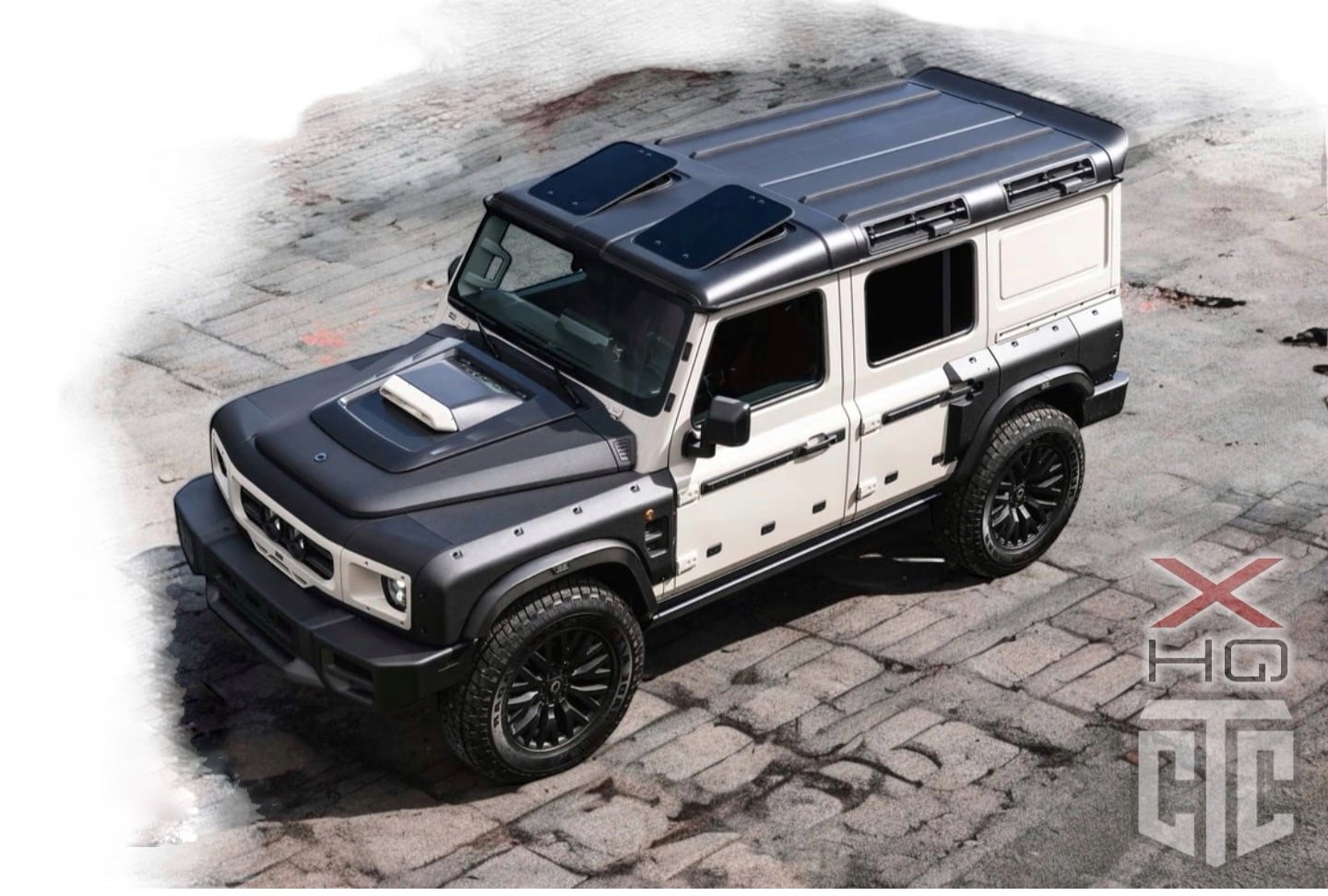
Why the Grenadier fit the philosophy
Expedition HQ didn’t back the Grenadier because it was hyped. They backed it because it’s built on a ladder chassis, uses proven mechanical components and is engineered around function. The platform suits Australian touring, station work and remote travel. And for a workshop built on expedition travel – not mall-crawling – that mattered.
The Australian aftermarket didn’t immediately deliver what the Grenadier needed, so Expedition HQ did what anyone with real expedition history would do – they built their own. Essentially EXSPEC was a response to gaps in available equipment, the demands of remote touring and the needs of working vehicles. The gear was designed around durability first and aesthetics second.
“Australia still demands genuine, mechanical 4WDs that can handle distance, heat, corrugations and isolation. The Grenadier arrived at a time when that segment was shrinking,” said Boswerger. “For Expedition HQ, it filled a gap we’d been watching widen for years – customers wanting a modern vehicle, but without the fragility and complexity that can limit remote travel. It also allowed us to offer something that could be driven daily, then prepared properly for serious off-grid travel without fighting against the vehicle’s original design intent.
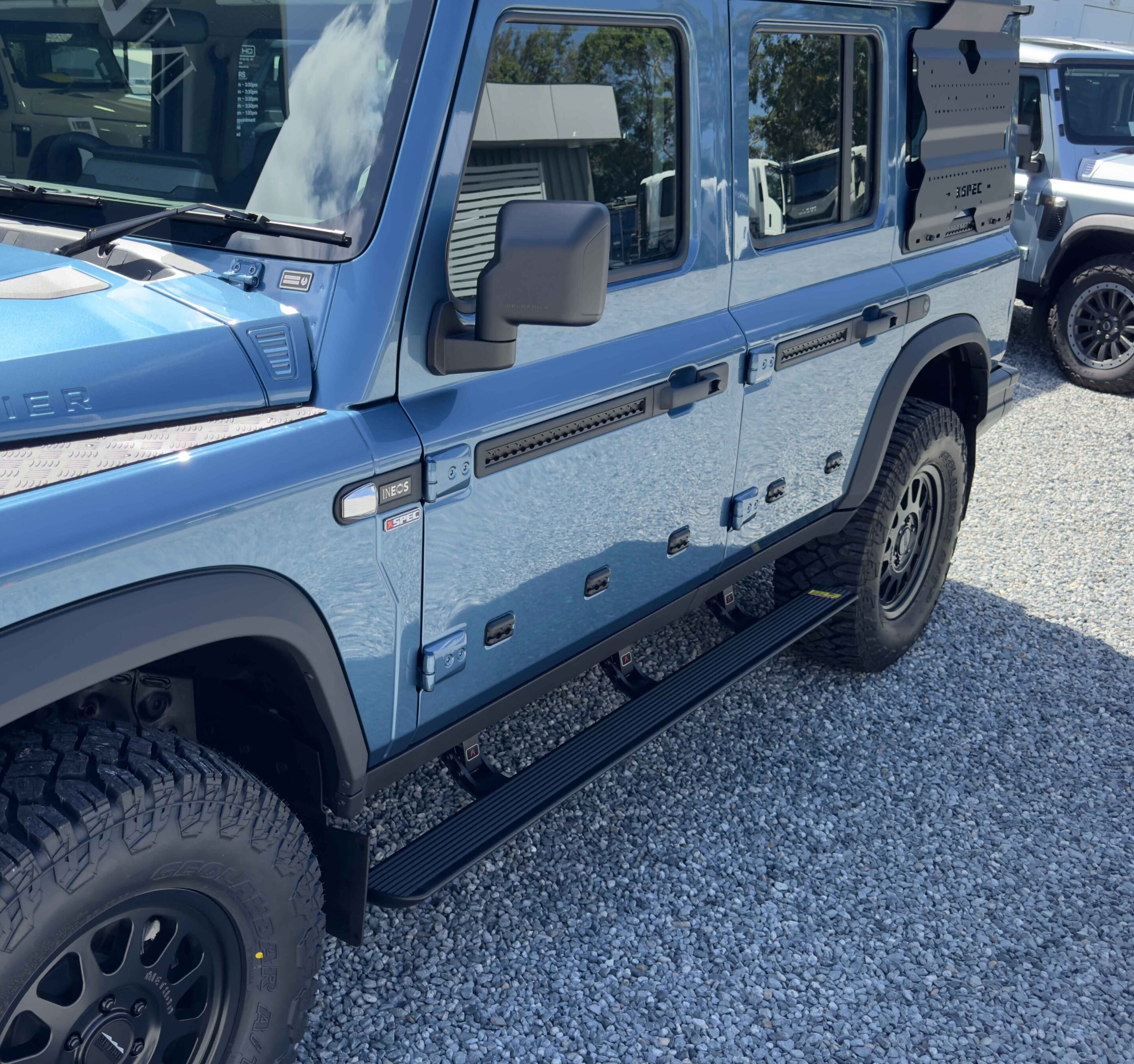
“The Grenadier is unapologetically functional. Ladder frame, solid axles, proper transfer case, mechanical switches and a focus on longevity over trends. That mirrors SLRV’s philosophy exactly. We build tools, not toys. Vehicles that earn their keep through reliability, repairability and real-world usability. The Grenadier felt like it was designed by people who actually understood what happens to vehicles after 200,000 kilometres of hard use,” added Boswerger.
If you walk into Expedition HQ today, you’ll see Grenadiers lined up in various build stages, accessories tested and fitted on real customer vehicles, and EXSPEC components developed from on-road feedback. You’ll also find a team who speak the language of touring, repairs and capability – not marketing.
But the important part isn’t what they sell now. It’s why they sell it. Because their story didn’t begin with the Grenadier. It began with expedition travel – and the Grenadier simply aligned with the philosophy they already lived by.
“We’re not a retail-only operation,” Boswerger told us. “Expedition HQ grew out of vehicle design, fabrication, field testing and recovery experience. We’ve broken vehicles in deserts, repaired them on tracks and lived out of them for months at a time. That means when we talk about modifications, servicing or set-ups, it’s not theoretical. It’s based on what fails, what survives and what actually makes life easier when you’re days from the nearest town.”
XSPEC drawer system
The XSPEC drawer system for the Grenadier is a good example of a piece of gear designed for durability first, aesthetics second.
“It was designed as a load-bearing storage solution first, not a furniture piece. The structure is built to handle constant vibration, heavy payloads and long-term use on corrugations, with robust materials, solid mounting points and simple, proven hardware,” said Boswerger. “It’s not about glossy finishes or tight tolerances that only work when the vehicle is new — it’s about drawers that still slide properly after years of dust, heat and abuse. The look is deliberately understated, because in remote travel reliability always comes before appearance.”
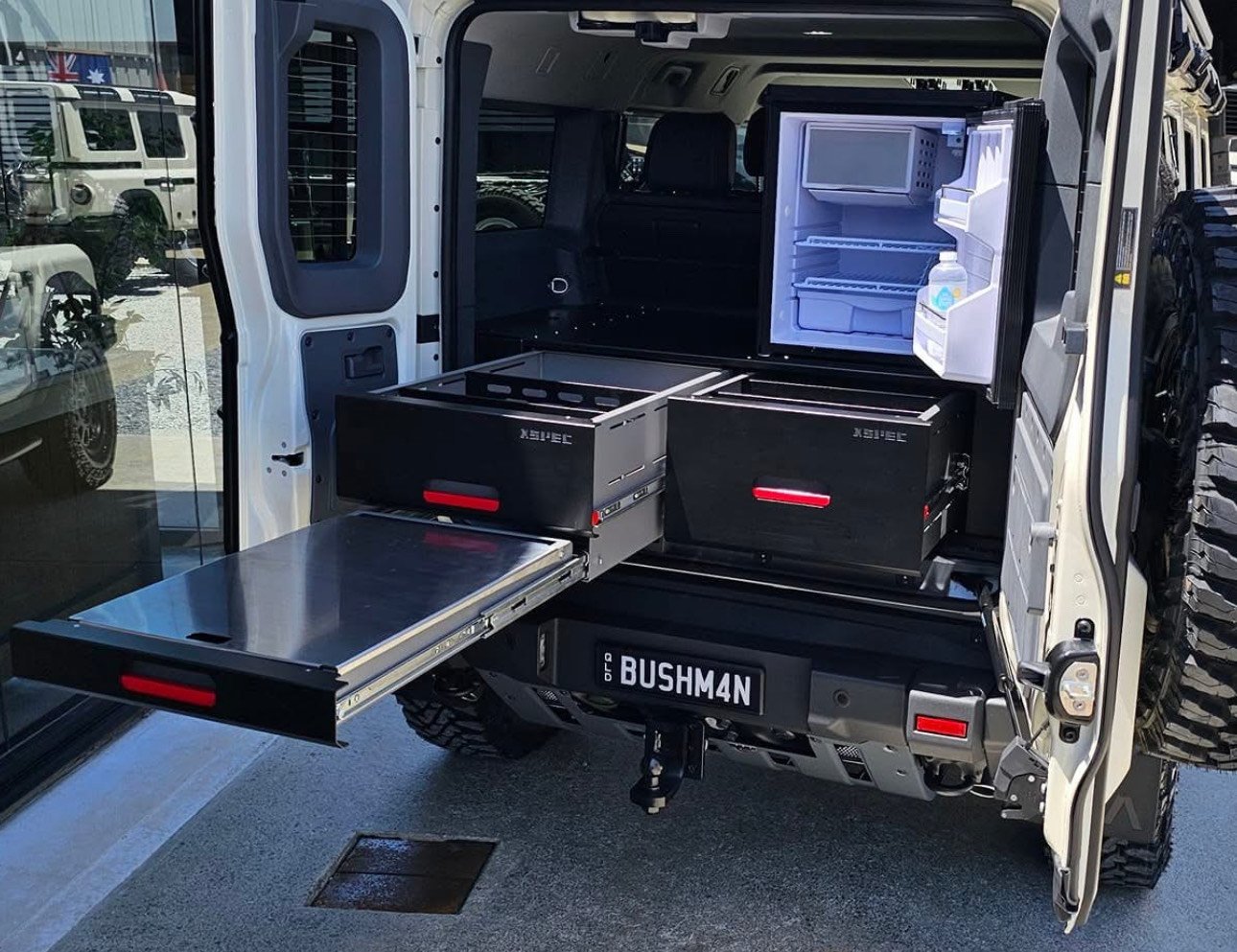
What’s next?
The Grenadier is a key platform for Expedition HQ moving forward, particularly as they expand purpose-built touring and expedition solutions around it.
“Beyond that, we will continue doing what we’ve always done: Developing vehicles and systems for serious travel,” said Boswerger. “Whether that’s compact expedition platforms, advanced electrical solutions or complete off-grid vehicles. The common thread remains the same – durability, function and real-world capability.”
Why the Ranger Was the Clear Choice
For Stuart, owning a ute has always been about more than practicality. It’s about safety for his family, capability for his work, and the freedom to get outdoors whenever the opportunity comes up. After doing his homework, comparing models, and thinking long-term, he landed on a vehicle that ticks every box: the Ford Ranger PX3 XLT 3.2-litre diesel dual-cab — one of the final PX3 models.
Life With the PX3 XLT
Three years in, Stuart’s confidence hasn’t wavered. His Ranger is covered by a five-year warranty, including parts, and he keeps it serviced at the Ford centre in Brookvale.
Most of his driving is close to home on the Northern Beaches. Living in Allambie Heights means short, frequent trips — school drop-offs, commuting to work, and errands within five kilometres of home. But that everyday ease is exactly what he loves. The Ranger feels steady, predictable and comfortable, whether he’s carrying gear, the family, or both.
When the Ranger Needs to Work Hard — It Does
Stuart has put the Ranger to the test with towing, too. One of his standout moments was hiring a 15-foot caravan in Western Sydney and heading up to the Central Coast with his wife and son.
It wasn’t just the towing ability that impressed him — it was the confidence. The 3.2-litre diesel had all the power he needed for overtaking on the highway, and he never felt unsettled or underpowered.

Taking the Ranger Off-Road — Including the Stockton Beach Sand Dunes
Stuart loves getting the Ranger off the bitumen, and he’s taken it through challenging terrain. A favourite is a track outside Goulburn, featuring steep climbs, river crossings and wombat holes. The PX3 XLT handles it all — stable, capable and fun.

A Ute That Fits Every Part of Stuart’s Life
For Stuart, the PX3 XLT isn’t just a vehicle. It’s a safe family car, a reliable workhorse, and an adventure-ready 4WD that opens the door to experiences — from local errands to off-road weekends to unexpected dune-driving detours. It’s the capability, comfort and confidence that keep him loving it every day.
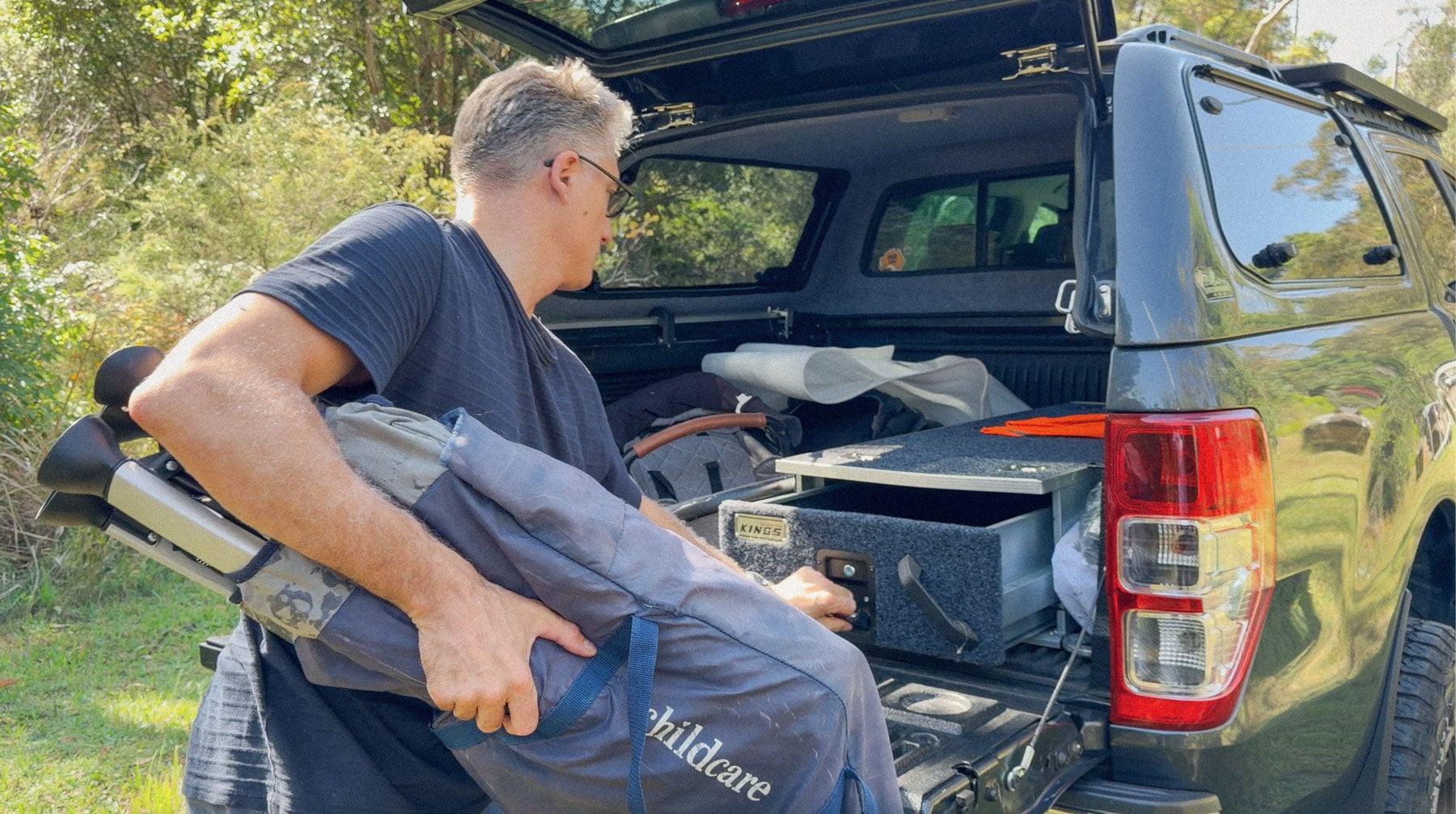
Why the Wildtrak Was the Right Fit for Leigh
For Melbourne gym owner Leigh Whitney, the search for a new ute was all about finding a vehicle that could match his active family lifestyle. After test-driving multiple models and diving deep into 4×4 comparisons, the next-gen Ford Ranger Wildtrak consistently came out on top. It had every feature he wanted, the right blend of capability and value, and a reputation for comfort and usability that suited their five-person household perfectly.
Life With the Next-Gen Ranger
Stepping out of his eight-year-old BT-50 and into the Wildtrak felt like shifting forward a generation. The technology alone — adaptive cruise control, driver-awareness systems, Apple CarPlay and the large central display — transformed Leigh’s day-to-day driving. Whether he’s commuting around Hampton, running errands for his gym Sweat Master, or doing school runs, the Wildtrak feels refined, intuitive and surprisingly easy to manoeuvre.
Family Adventures, Mountain Bikes and Snow Trips
Weekends for the Whitney family revolve around activity — mountain biking, sport, and longer road trips whenever time allows. The Ranger’s tub effortlessly fits three or four bikes, made even easier with the addition of a rack and the electric roller shutter. On bigger trips, everything goes in the back — wet, dirty, bulky, it doesn’t matter — and the Wildtrak never feels weighed down.
Snow destinations like Thredbo, Perisher and Jindabyne are regular stops on their calendar. With five on board and a full load of gear, the Ranger stays stable and smooth, making long-distance runs feel effortless. Now that Leigh has a proper 4×4 — not just a 4×2 — he’s excited to explore more trails in the mountains and make four-wheel driving a bigger part of future trips.
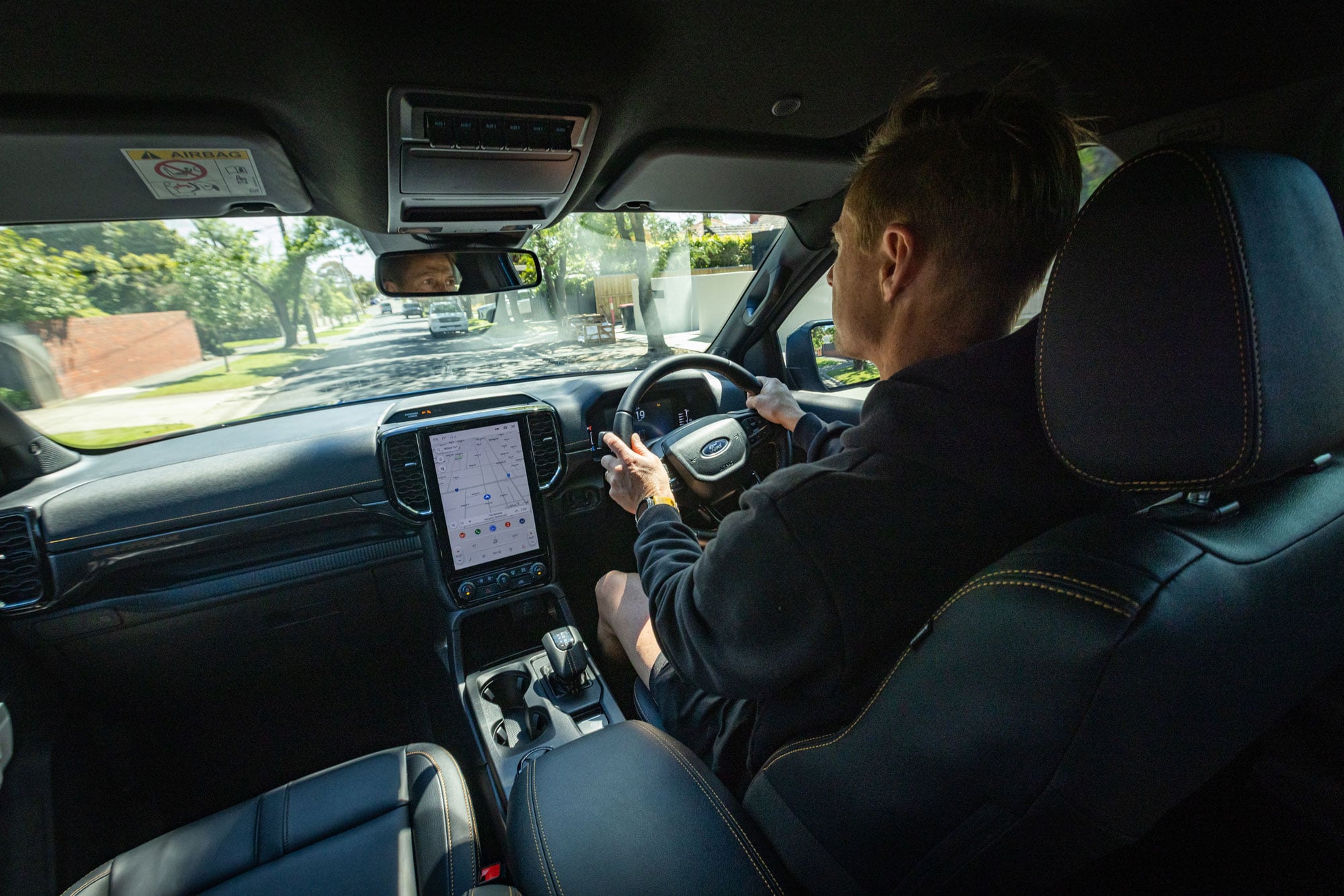
The Comfort and Tech That Make Long Drives Easy
Compared to his previous utes, the Wildtrak’s ride quality stands out immediately. The adaptive cruise control takes the fatigue out of long drives, while the advanced lighting system — which automatically adjusts to highlight dark patches on country roads — has become a favourite feature for family trips to Sydney. The whole vehicle simply feels designed around effortless travel.

A Versatile Ute Built for Their Busy Family Lifestyle
What Leigh appreciates most is the Wildtrak’s versatility. It handles weekday errands as easily as it handles long-haul family travel, outdoor adventures and off-road plans. His young son loves the tech and the “cool-factor”, his mates rate the look, and Leigh sees it as a ute that enhances how they live — making every trip smoother, easier and more enjoyable. For a family constantly on the move, the Ranger fits perfectly into every part of the lifestyle they love.
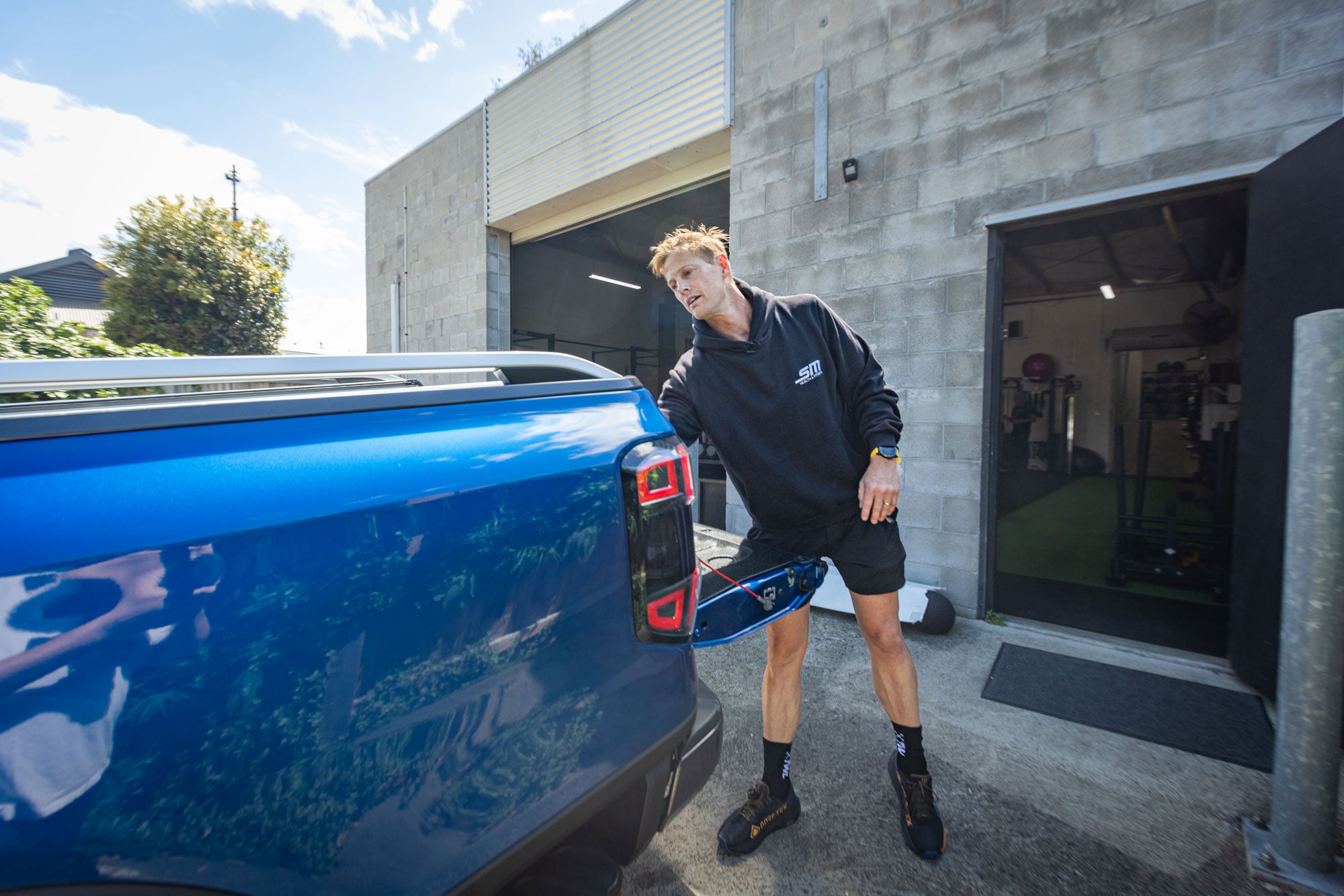
Why Connor Chose the Ranger
For Connor McNally, an event manager for Cricket Australia, life is constantly moving — early mornings, shifting venues, and quick escapes whenever time allows. When he bought his 2016 Ford Ranger toward the end of the COVID-era market chaos, he needed a ute that was powerful, affordable and ready for anything. The Ranger stood out for its real-world capability: strong towing performance, rear diff lock as standard, and the reliability he could trust day in, day out.
How the Ranger Fits His Work and Travel
Across Melbourne and beyond, Connor uses the Ranger as a mobile workspace. The metal canopy and custom rear setup let him haul equipment between offices and event sites without fuss. But once the work week wraps, the Ranger transforms into his getaway vehicle. With a dual-battery system and fridge running full-time, he can throw a swag in the back, hook up a trailer or take off for a spontaneous winter trip with almost zero prep.
Towing, Trips and Real-World Capability
What Connor values most is how consistently the Ranger delivers. From towing his 1,600kg boat to running long highway stretches, it feels surefooted and strong — a big step up from other vehicles he’s towed with, including an MU-X. Even in Tasmania’s freezing August weather or South Australia’s 38-degree heat, the Ranger never faltered. And with a lift and plenty of clearance, it’s taken him deep into the kind of tracks he lives for.

Taking the Ranger Further — From Tasmania to the Gibb River Road
Connor’s Ranger has carried him across some of the most memorable corners of the country: the wild west coast of Tasmania, the sweeping beaches of Rapid Bay, and iconic outback favourites like Cash Island, the Gibb River Road and the Dampier Peninsula. Whether he’s travelling solo or with his partner, the Ranger has even doubled as home for month-long stretches — something few vehicles can genuinely handle.

A Dependable Companion for Every Chapter of His Life
At close to 240,000km, with dents and scratches inherited from previous owners, Connor’s Ranger wears its history proudly. To him, that’s the beauty of it. It’s dependable, capable and always ready for what’s next. Whether towing, camping or simply squeezing more adventure into his weekends, the Ranger is the vehicle that keeps pace with every part of his life.
